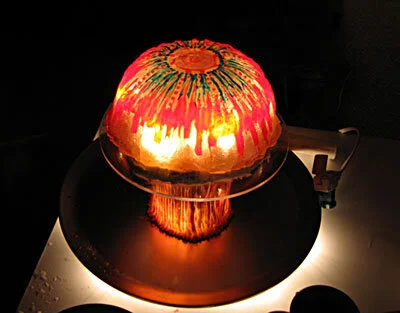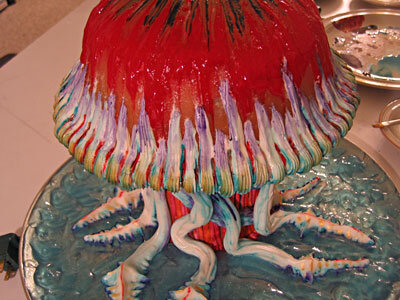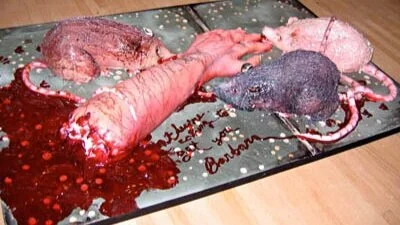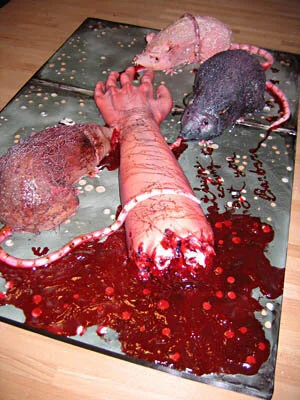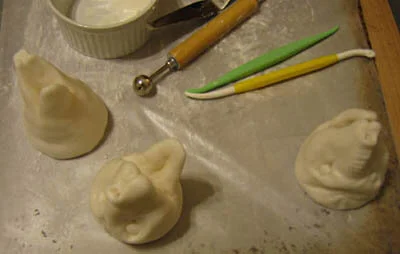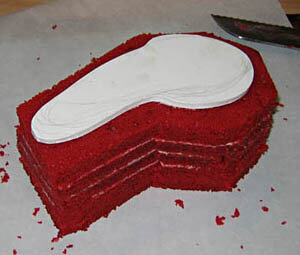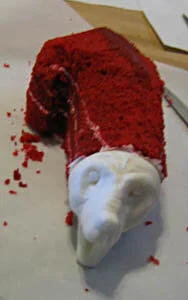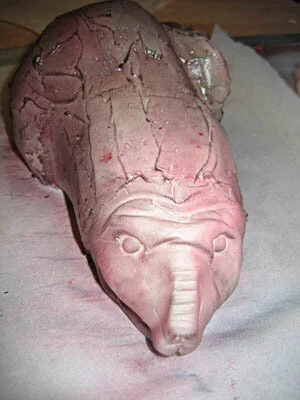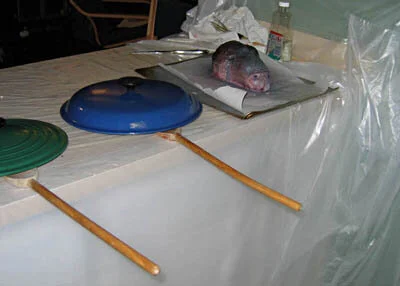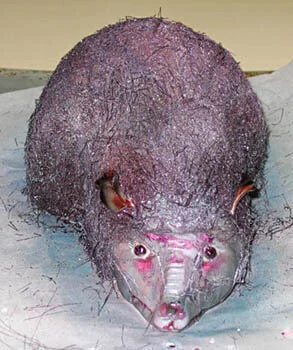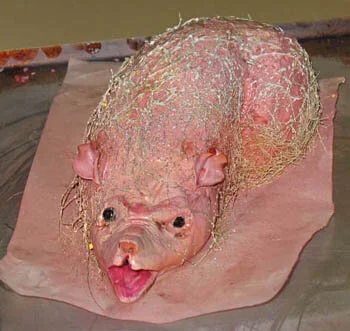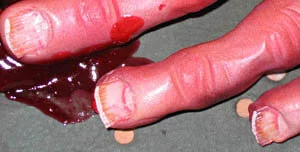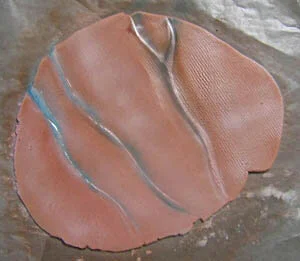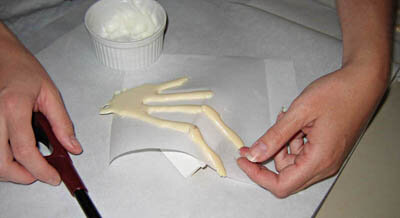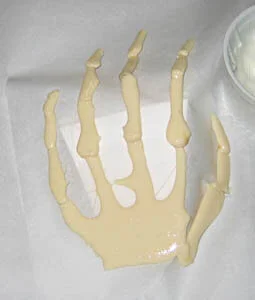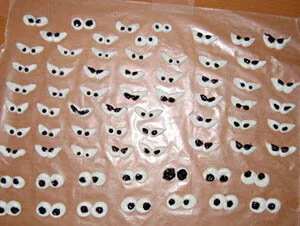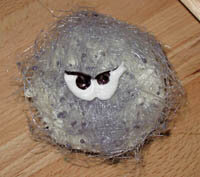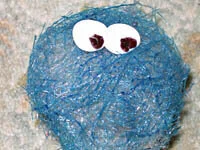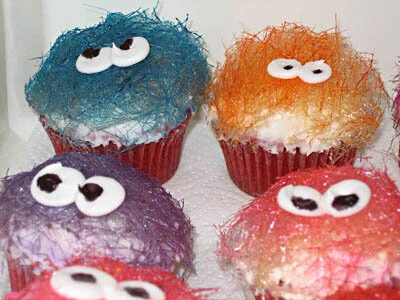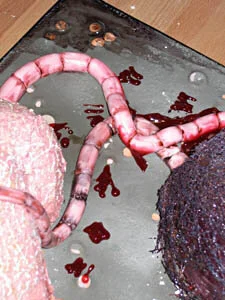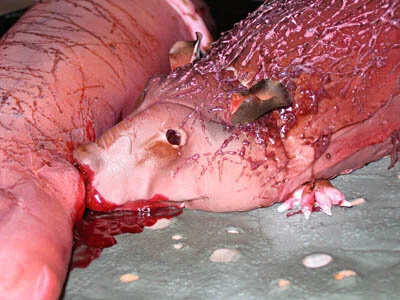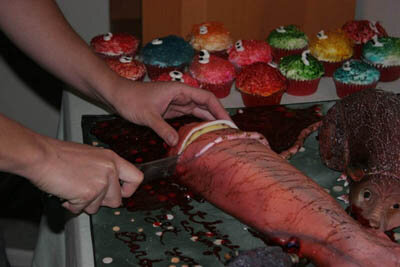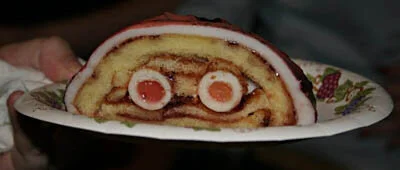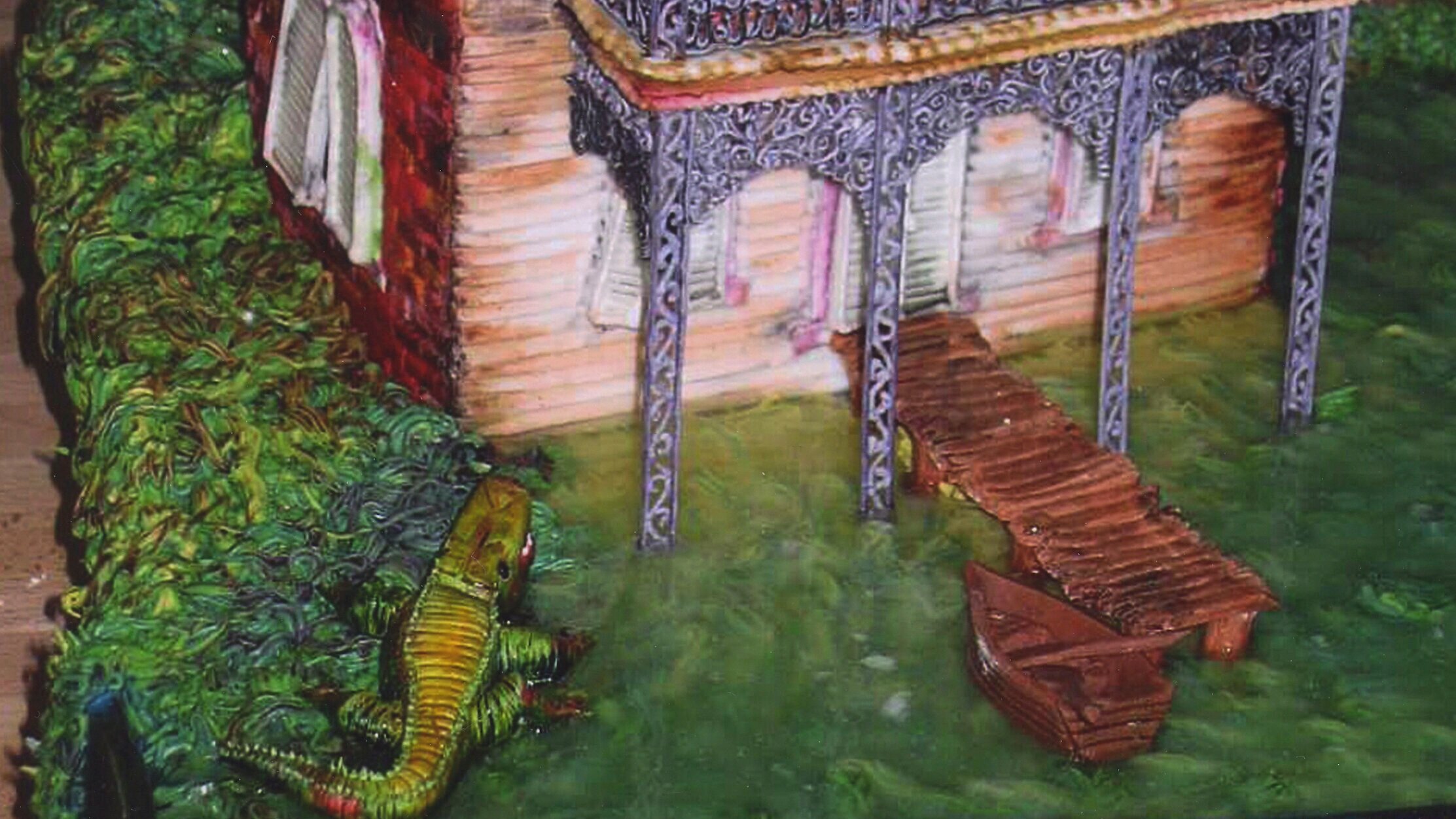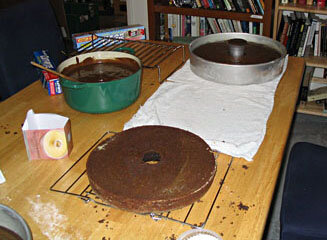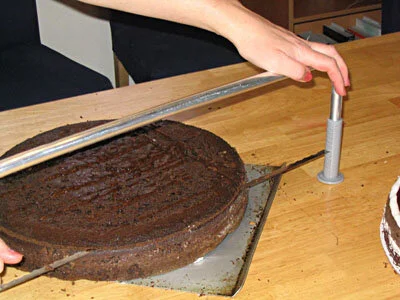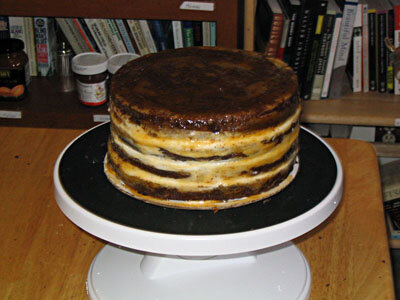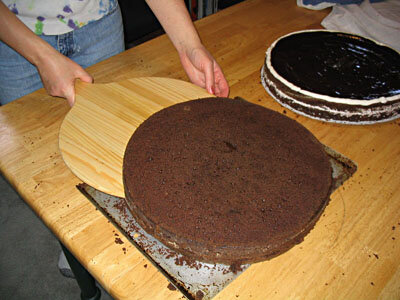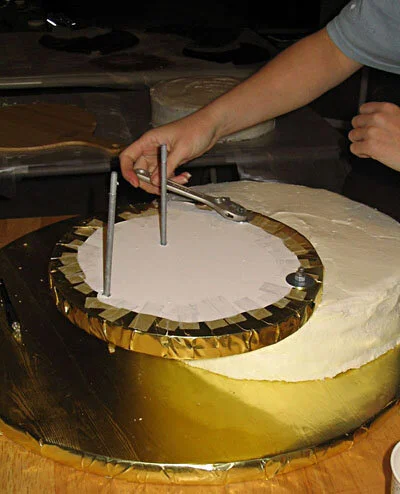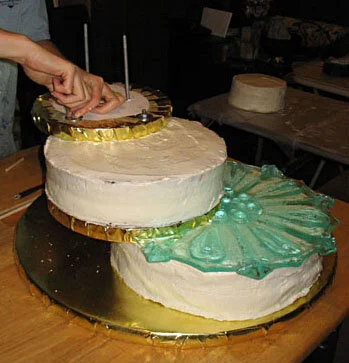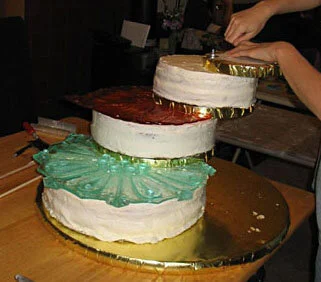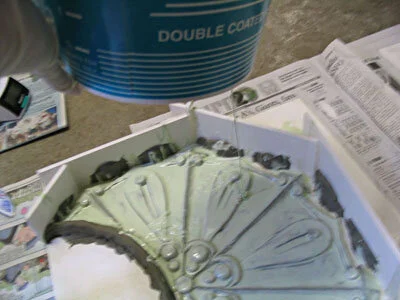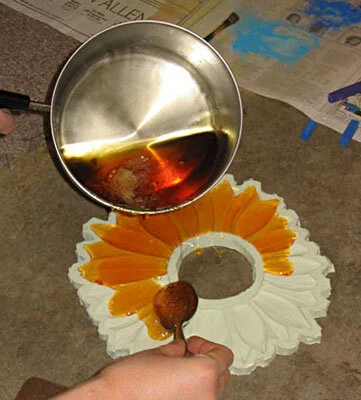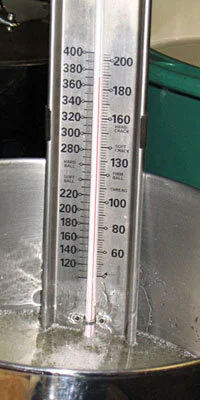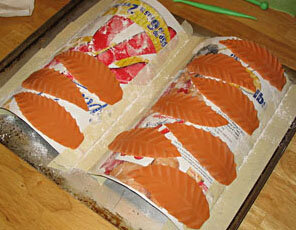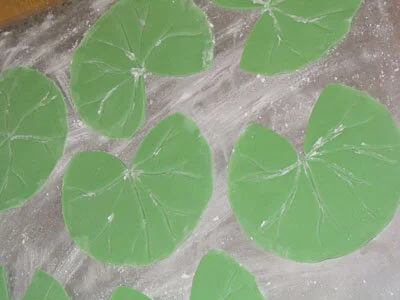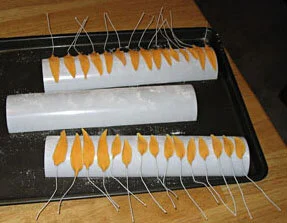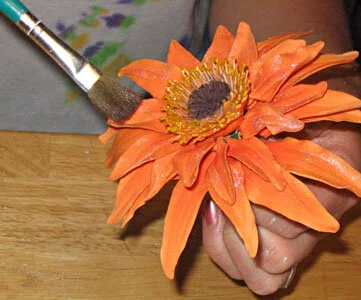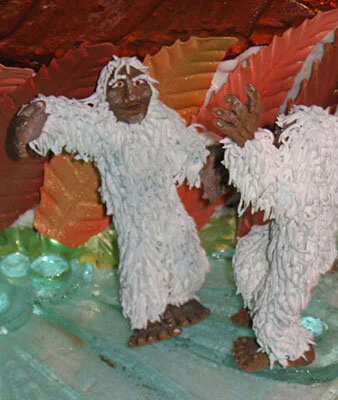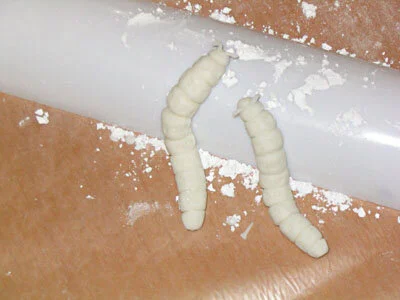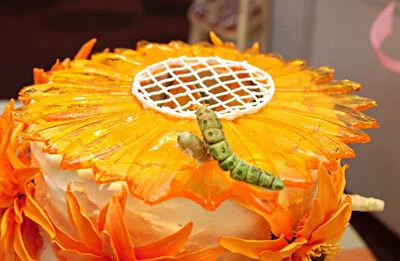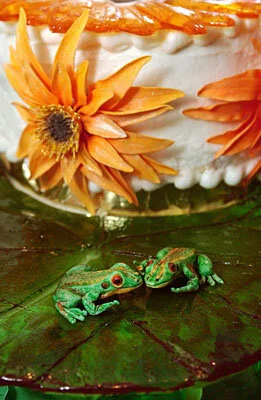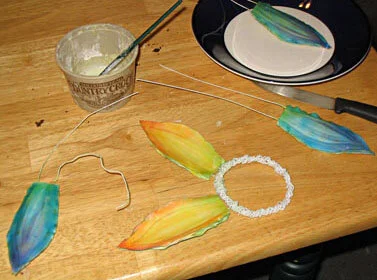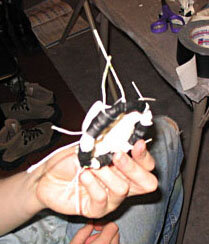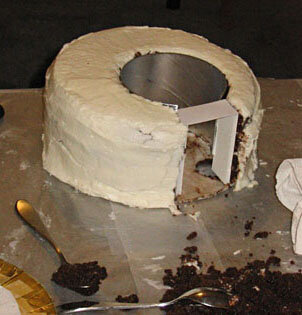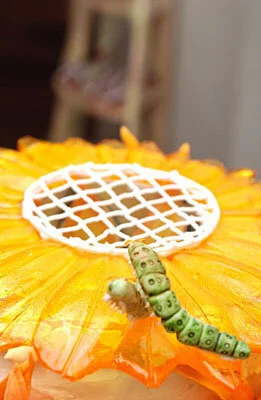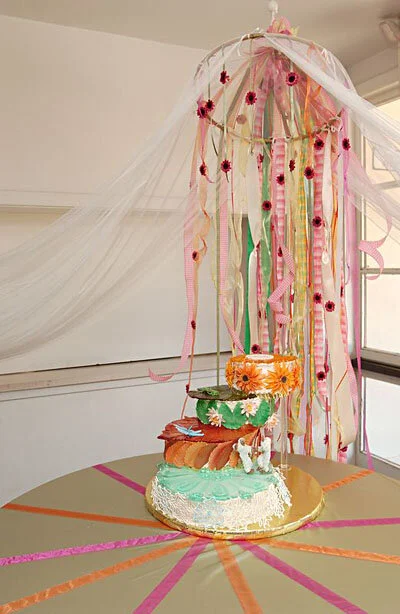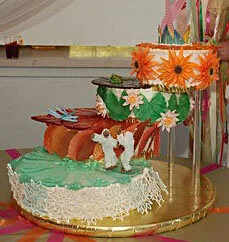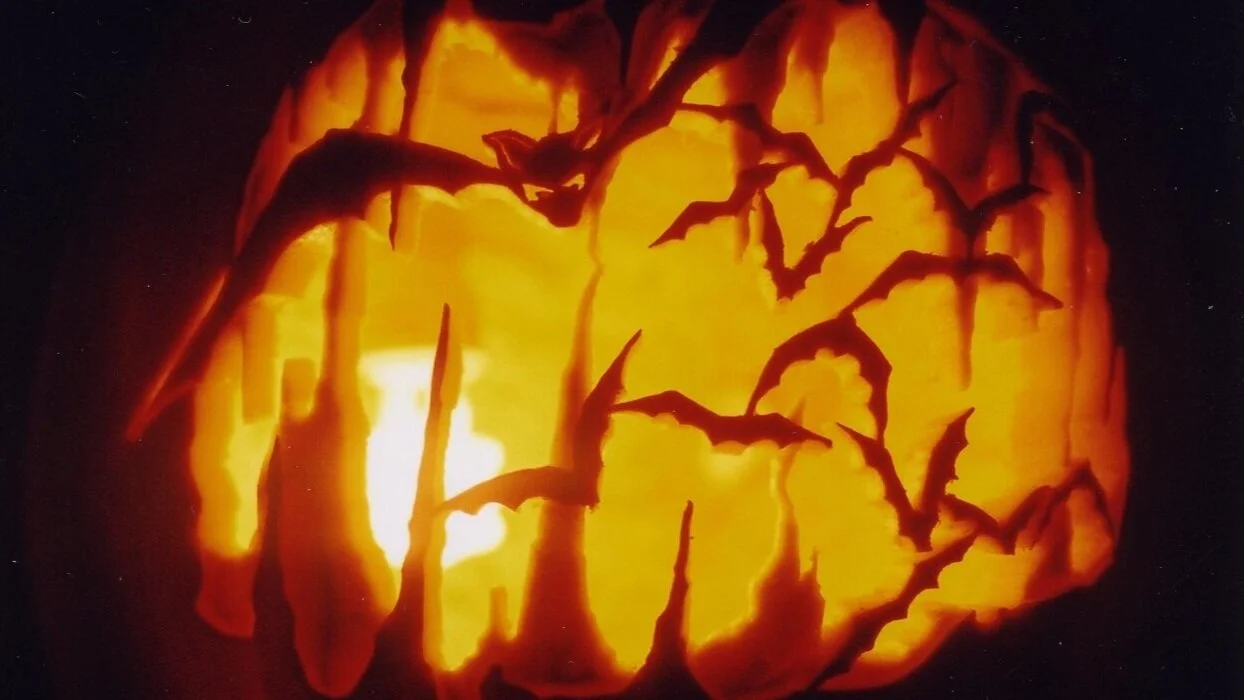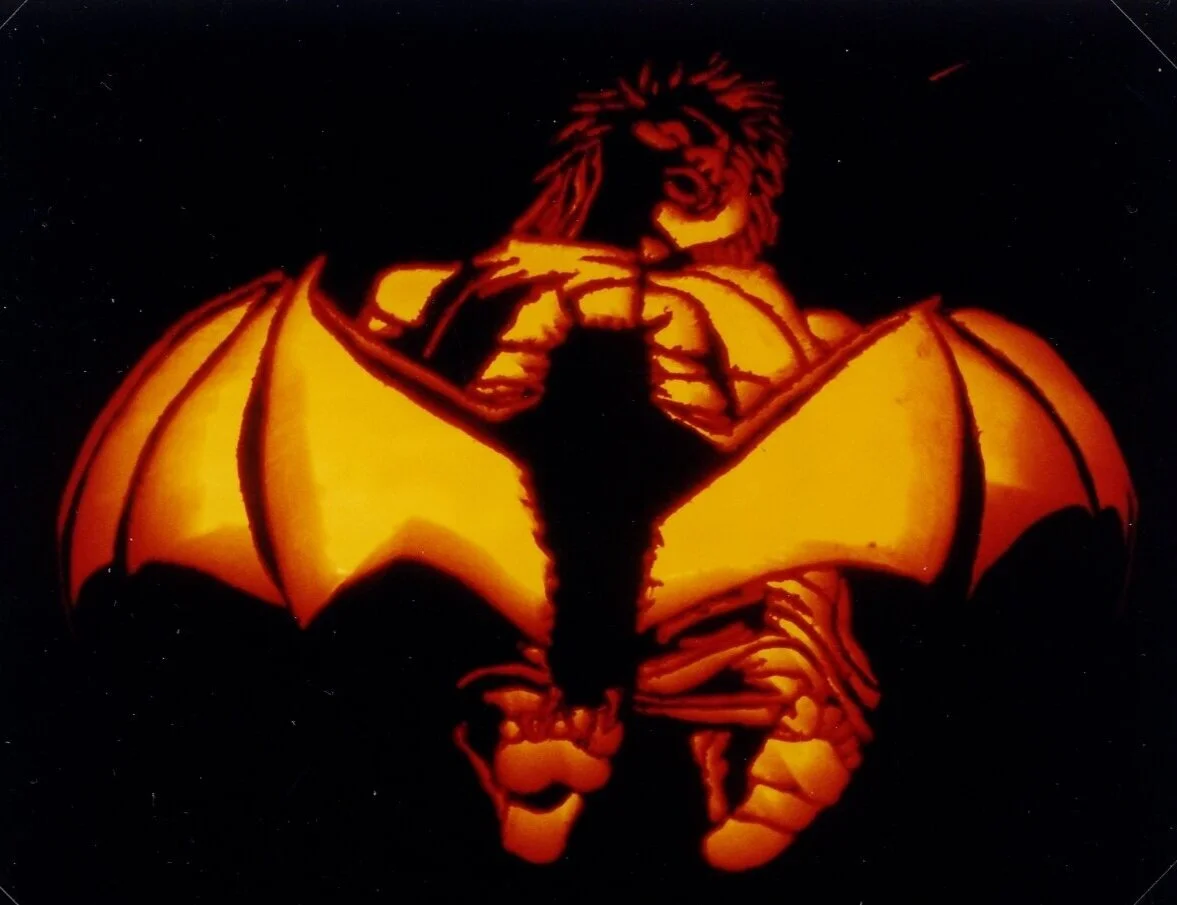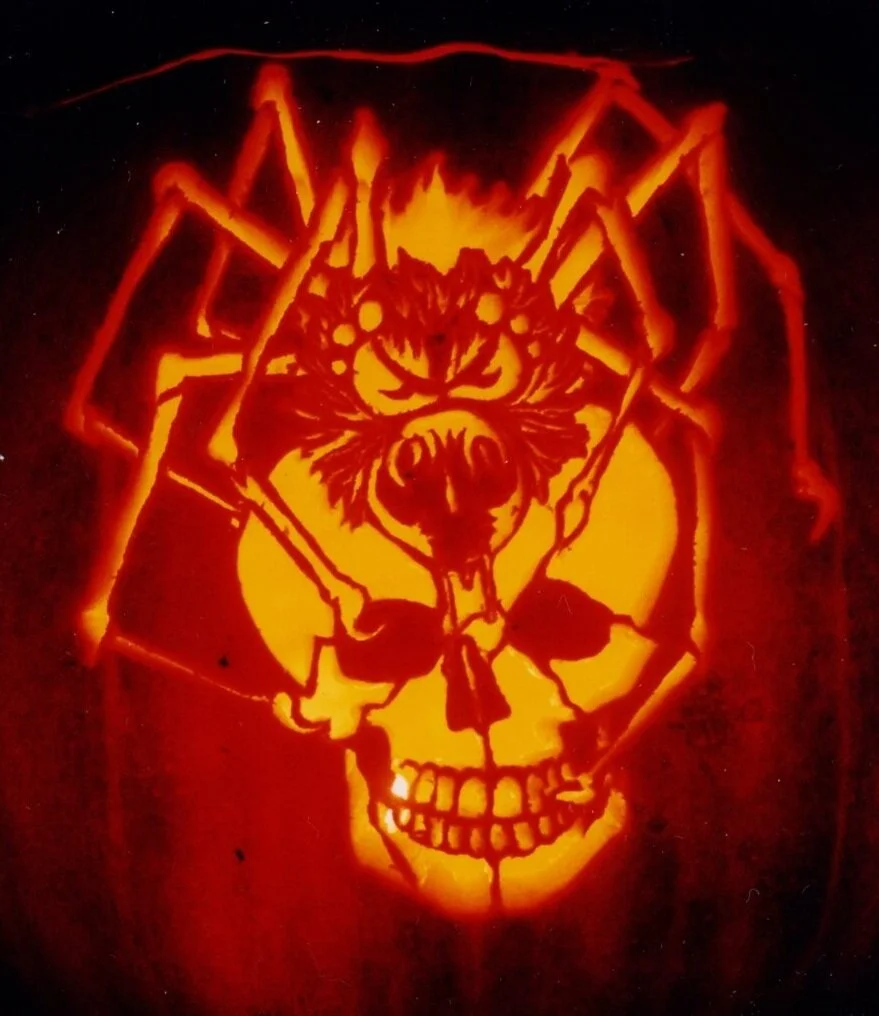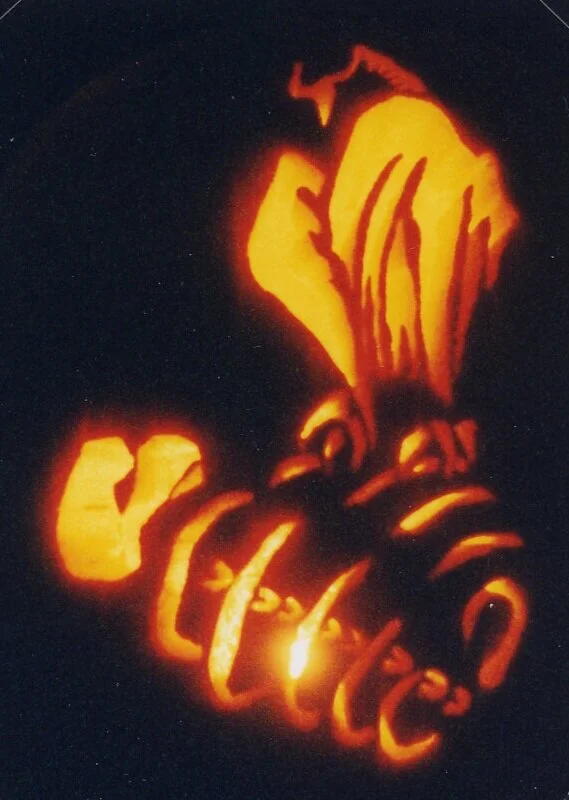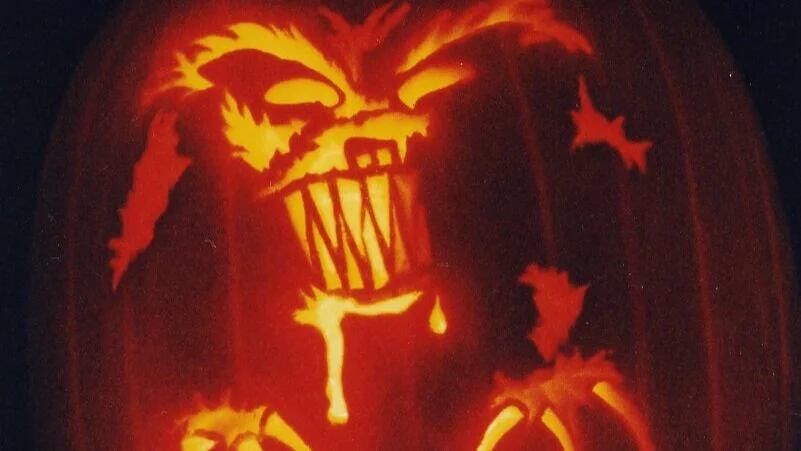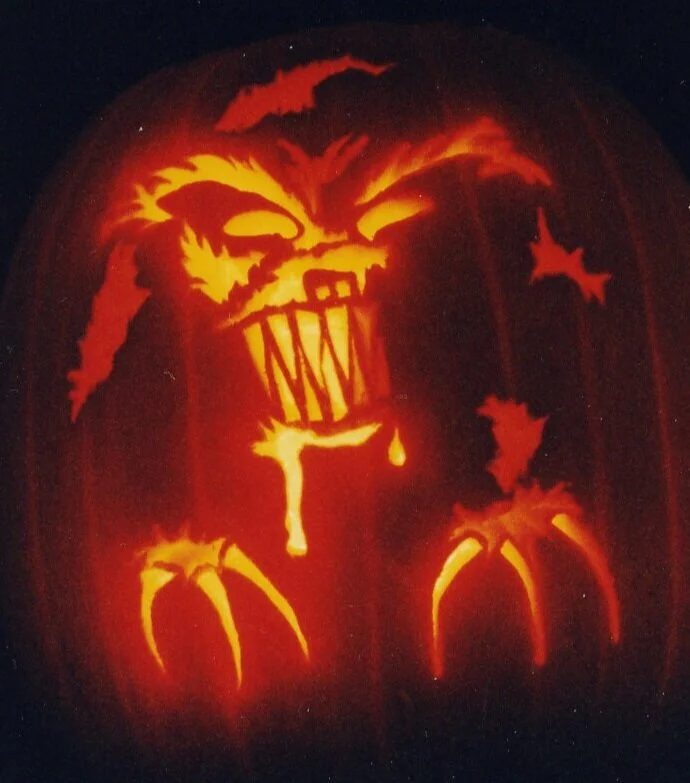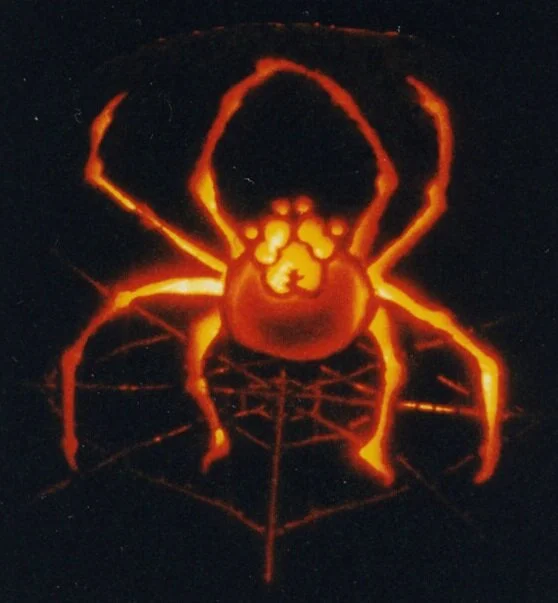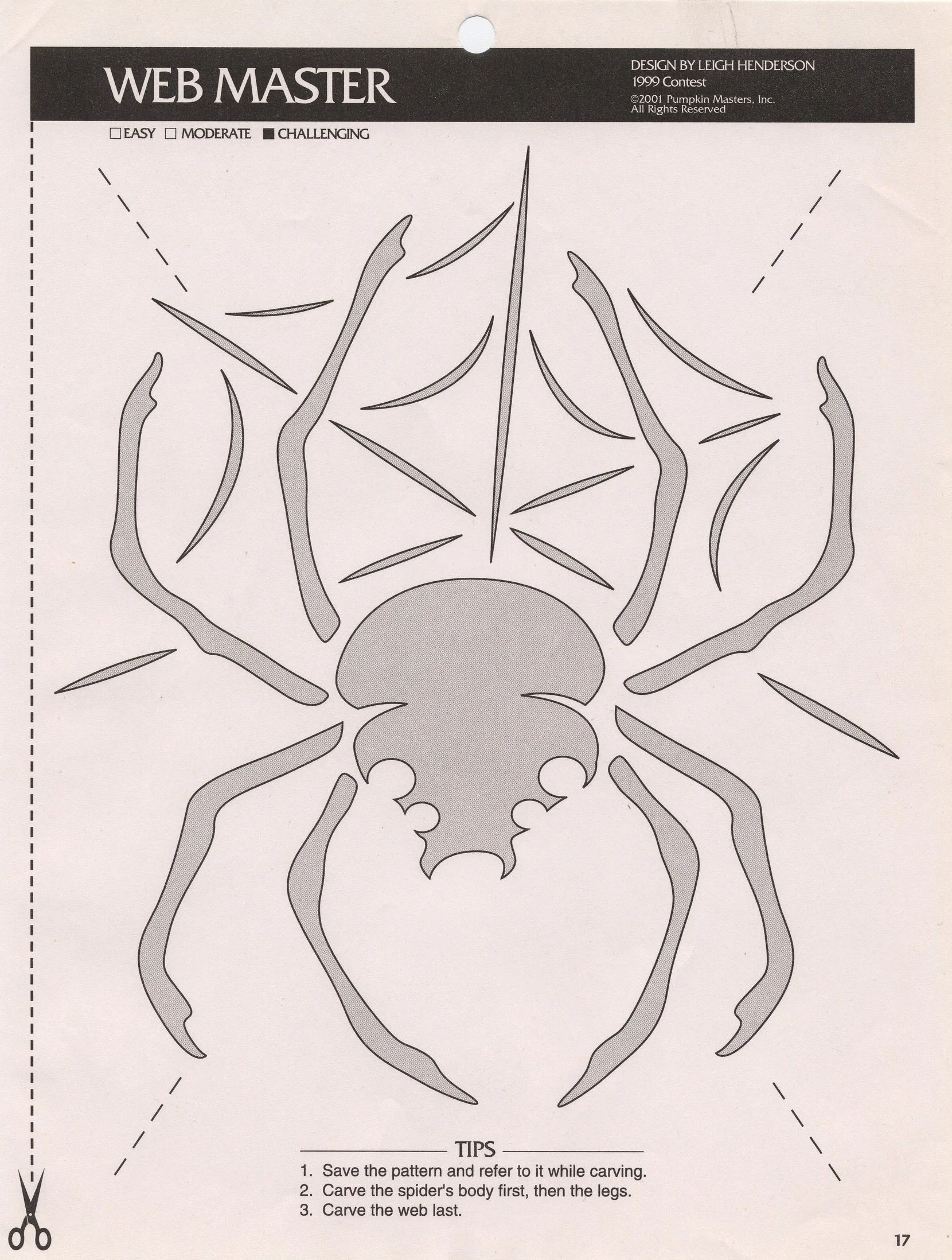Jellyfish Cake
One of the first things that I did when I arrived at MBA school was to brag to my new friends about my cake-making prowess. Naturally, my bravado was met with a request for a birthday cake. At this point I had known the birthday girl for all of two months. Not having that much to go on in terms of personalizing the cake, I decided to make a glowing jellyfish, based solely on the fact that she had happened to mention a recent trip to the aquarium.
One of the first things that I did when I arrived at MBA school was to brag to my new friends about my cake-making prowess. Naturally, my bravado was met with a request for a birthday cake. At this point I had known the birthday girl for all of two months. Not having that much to go on in terms of personalizing the cake, I decided to make a glowing jellyfish, based solely on the fact that she had happened to mention a recent trip to the aquarium.
The plan was for me to serve this cake during class at our Arts Administration Seminar, which meant that I had to transport it from my apartment to school. Naturally, I responded to this requirement by making a cake based on one of the most delicate, ethereal creatures on earth.
Because I wanted the jellyfish to glow from within, my first step was to make a hollow dome of hard sugar to serve as the bell of the jellyfish through which the light would shine. This marked my second attempt to make such a sugar dome (the first being the Cyndi Lauper cake) and it remains a very difficult thing to accomplish (or at least a very difficult thing for me to accomplish.) I used a metal bowl as the mold, covered with tin foil because I wasn't confident in my ability to release the sugar from the bowl otherwise. The problem with tin foil, of course, is that it doesn't lie perfectly flat and thus has a tendency to form ridges that get stuck in the sugar and have to be carefully pried out with tweezers and/or melted out with a wet paintbrush. The other huge problem that I always have in making sugar domes is that melted sugar, being a liquid, has a strong tendency to flow down the side of the bowl and thus form a deformed letter "o" with a bowl in the middle, rather than a dome. I counteracted this downward tendency by continually pulling the sugar back up the side of the bowl with a spoon until it cooled and hardened enough to stay in place. As you can imagine, this didn't result in the pristine, glasslike surface that I would have liked, so I had to settle for a streaky, lumpy jellyfish bell.
Next, I needed to get my glowing mechanism functional. My plan was very simple - put some Christmas lights between the cake on the inside and the sugar dome on the outside, forming the bell of the jellyfish. Obviously, in order to have some sense of the jellyfish floating gracefully in the ocean, I would need to raise this bell up on a pedestal from which the arms and tentacles could descend. I bought an acrylic cake stand that consisted of a round acrylic plate that sat atop a 6" diameter acrylic cylinder. In order to run the Christmas lights down from the bell, I drilled a hole in the top plate. This also allowed me to wad some of the Christmas lights inside the cylinder so that the tentacles would also glow from within. The strand of Christmas lights was too long for me to fit all of them into the cylinder and I still needed a way to get the plug out of the cake and into the outlet, so I mounted the acrylic cake stand onto a silver tray, which I also drilled a hole in so that the Christmas lights could come out the bottom of the tray. Then I took the remaining Christmas lights and taped them to the bottom of the tray, carefully, so that it was still able to sit relatively stably. This had the pleasant effect of making the cake appear to be floating on a bed of light, as if, perhaps, some phosphorescent fish were swimming around in the depths below.
To make the acrylic cylinder look more like a life form and less like an architectural necessity, I piped vertical stripes of royal icing all around it, using a big round tip. I think it was a #8. Because I was going for an organic look, I deliberately let some of the lines curve and slump a bit.
There wasn't a whole lot of room for the actual cake, but fortunately it only needed to serve eight people. I made a 6" round cake, carved it into a hemisphere and covered it with fondant. The cake fit easily into the center of the circle of Christmas lights, and I slathered on a whole mess of royal icing to conceal the green cord. I plopped the sugar dome over top of everything and more or less had a proto-jellyfish. But it still needed a lot of work.
For one thing, I wasn't happy with an all-white jellyfish, though in retrospect, it may have maintained a more ethereal quality with a more muted palette. Instead, I piped on a bunch of bright red and blue piping gel and painted the royal icing around the cylinder with food coloring to match.
At this point it looked more like an eerily glowing mushroom than a jellyfish. I needed life. I needed movement. I needed fondant tentacles. I had the good sense to leave these mostly white, with just some blue and purple edging and red accents on the tips, which certainly kept them more ghostly than they would have been with more color.
My next problem was that the acrylic circle of my cake stand was about two inches bigger in diameter than my sugar dome, so I needed some way to conceal the overhang. I used a big star tip to pipe a sort of elongated inverted shell border around the perimeter of the dome. Apparently the inverted shell border is a bit of a go-to decorating technique for me when trying to conceal imperfections. I went on to use it again on my niece's first birthday cake, with similarly unimpressive results. I also went in around the base of the cake with piping gel tinted blue to indicate water.
My jellyfish still looked too static for my taste, so I made some wispy royal icing arms to set round the edge of the bell. I attached them to the cake before I realized that would doubtless break during transport so I took them back off and painted them with some blue and green luster dust. I guess because I had the luster dust in hand I went a little shine-crazy at this point, slinging utterly garish amounts of blue, purple, and gold luster dust all over the place. Sometimes I just lose control of my paintbrush.
I had a bit of trouble transporting the cake to school because I drive a little pickup truck, which is great for buying lumber and for piling all your stuff in the back and moving across the country, but not very good for transporting cakes. Obviously it would be unwise to just chuck the cake into the bed, so I had to put it in front. Sadly, it wouldn't fit in the footwell, so I had to put it on the passenger seat, which, being designed for human butts, not for cakes, is neither flat nor level. I also had to drive down my driveway, which was both steep and bumpy. The upshot of all this was that the cake got knocked around a bit in transit and I had to make some repairs on site, as well as attach the wispy arms around the perimeter.
In conclusion, this was by no means my greatest moment as a cake decorator, but my friend still seemed to appreciate it.
Killer Rats Cake
The Killer Rats Cake was made for Son of Zombiefest, our celebration of the posting of our 300th review.
Introduction
The Killer Rats Cake was made for Son of Zombiefest, our celebration of the posting of our 300th review. Actually, to be fair to the rats, I don't really know that they killed the man they're eating. It's possible that they simply came upon the severed arm and decided it would make a tasty snack. That's why I referred to it through much of this process as the Rat-Arm Cake, but my sister pointed out, and I agreed, that was a very uninspiring title, so "The Killer Rats Cake" it became. Like its illustrious predecessor, The Zombie Cake, The Killer Rats Cake began life as a pattern for a carved pumpkin. Both the pumpkin and the cake depict a severed human arm being devoured by three large, ugly rats. Well, ugly in their cake incarnation, at any rate; they're sort of cute on the pumpkin. The cake arm was constructed in layers, from the inside out, so that a slice of the cake looked like a cross-section of an arm, complete with ulna, radius, bone marrow, skin, etc. Admittedly, this did not make for a spectacularly dynamic presentation, at least as compared to the cakes that burned or shot blood or secreted bodily fluids, but I think it was just as effective, in its understated fashion. Sometimes even I opt for subtlety and finesse over gaudy drama.
Because the cake was created in several separate segments, then assembled, I'm going break up this narrative accordingly, although in reality these processes were occurring simultaneously.
The Rats
The first step in constructing the rats was to make the gum paste and fondant pieces that needed time to dry before they could be attached to the cake. I did this about five days before the party.
The rat ears are simply gum paste, rolled very thin, then cut into the shape of ears. I then thinned the edges even further with a ball tool and pinched the bottoms together to give the ears the appropriate shape.
The rat faces were a much more difficult proposition. As I always do, I started by finding a few good research photos to work off of. Of course, I couldn't find any pictures of rats that were as mean as I wanted my rats to be, so I supplemented the photos with the use of a really ugly, vicious, battery operated rat toy that I once bought for my sister at a KB Toys that was going out of business.
I made the rat faces out of a fifty-fifty mixture of gum paste and fondant. At first I had a lot of trouble sculpting them because I couldn't figure out how to handle them and set them down without distorting the features I had already carved. Eventually I discovered that I shouldn't try to pick them up, just set them on wax paper, noses facing up, and work on them that way. After that, things went much more smoothly and, with the help of various gum paste sculpting tools and a lot of shortening to keep the gum paste-fondant mix moist enough to work for the requisite period of time, I was able to crank out three pretty vicious looking rat faces, two with open mouths, one with mouth clenched as if he were in the process of ripping off a succulent morsel of flesh.
The next step was to cut a foam core base for each rat, which obviously necessitated my planning the body shape and position of each rat, so I would be able to stick the base to the cake, then carve around it.
Finally it was time for the actual cake. My sister was kind enough to bake the cakes for me. We used a red velvet cake recipe so the rats would look nice and meaty inside, and we started with three 10" round cakes. I then took each cake, leveled the top and split it into two layers using a cake leveler. Cutting each of these layers in half along the diameter of the circle allowed me to assemble the four resulting pieces into a four layer cake shaped like a semi-circle. I used buttercream icing as my filling between layers.
Once I had torted and filled all three cakes in that fashion, I was ready to carve, which is one of my favorite parts of the cake construction process. I started with the first cake upside down and stuck the foam core base to it with buttercream icing. Using a small, sharp kitchen knife I cut the cake so that it was about half an inch larger than the base all around, then flipped the cake sight side up. I then did the more detailed carving, rounding the body, giving the rat haunches, and cutting the front carefully so that the head would line up properly.
Having carved all three cakes, I was ready to attach the heads, which I did using buttercream icing, reinforced with a toothpick stuck between the back of the head and the front of the cake. I then frosted the rats with buttercream icing. I took two layers of icing, with some dry time in between, to cover most of the red in the cake.
Before adding fur, I used my cake airbrush to put a base coat of color on each rat. I planned to make one white rat, one brown rat, and one grey rat. For the white rat I used a pink base coat with some darker red and orange shadows. For the brown rat, I used a reddish-brown base, but left some lighter pink highlights. For the grey rat, I used a medium grey base, but with lighter grey and pink highlights. Then I decided that I wasn't satisfied with them, so I airbrushed in even more shadows and highlights.
The next step was the application of fur, which was made of spun sugar. I had decided, after a few experiments, for the sake of time to make all the fur colorless, then airbrush on the colors. Using Jacque Torres's recipe for spun sugar, I set up two long wooden spoons hanging over the edge of the counter, wrapped half the kitchen in plastic bags, then proceeded to fling hot sugar absolutely everywhere.
Because my spun sugar tools had a tendency to get gunked up and need to be washed after only five or six uses, it was good that I had two. One was a whisk with the curved ends cut off; the other was a wooden ruler with some cut up pieces of wire taped to it. The wire ends of either tool were dunked into a bowl of hot sugar, then whipped back and forth over the two wooden spoons, leaving a trail of thin strands of sugar behind. I then scooped up these thin strands and draped them over the rat bodies. After I had finished the first rat, I decided I had put too much fur on it, so I did less fur on the other two. As it turned out, I was wrong. The first rat, the one with more fur, wound up looking better than the other two.
Airbrushing onto spun sugar turns out to be a tricky operation because the sugar is so thin that it tends to dissolve if it gets wet. Long story short, I oversprayed the rats and the two with less fur wound up looking patchy and diseased. I rationalized this by saying that the scene took place in some kind of abandoned government lab which was full of all sorts of chemicals and viruses and the like. No wonder the rats are diseased! The rat that I thought had too much fur wound up looking really good.
Before applying the final coat of airbrushed color, I stuck ears to each rat, by simply jamming the bottoms of the ears into the cakes. I obviously should have attached them better, because several of them fell off and later had to be reattached.
There are details too delicate to the airbrushed onto cake rats, so I went in with a little brush to paint the insides of mouths and ears and eyes and noses. I also gave little white royal icing teeth to the one rat whose mouth remained open. The other rat that was supposed to have an open mouth settled somewhere along the line and wound up with a closed mouth. The third rat, of course, had a closed mouth to begin with.
The rats still needed, feet, tails, and bloody snouts, but that had to wait until they were positioned on the cake base, so I'll cover that in the Assembly section, which means we're ready to move on to the arm.
The Arm
To begin with, I needed a picture of an arm to work from. I couldn't use my own arm as model, because I wanted a big, hairy man arm. So I turned to my brother-in-law, my sister's husband, who was a very good sport about me photographing his arm and incorporating it into the cake.
The first step was to make the fingernails out of gum paste. My brother-in-law has much flatter, squarer fingernails than I do, so it took me a while to get the hang of them and to find an appropriately curved surface to drape them over to dry. I also discovered that the key to sculpting realistic fingernails is the subtle, vertical striations. Take a close look, you'll see what I mean.
I wanted to experiment with the skin before trying it on the real cake, both to find a good skin texture and because I hadn't used the airbrush much before and I wanted to make sure I knew how to handle it. So I rolled out some fondant and tried texturing it by pressing on it with various fabrics. The winning texture came from a blue dishtowel. I then made a couple of samples complete with protruding veins and let them dry before practicing airbrushing on them.
On the extras of one of the Lord of the Rings DVDs I saw a special effects guy explaining how the way to get a realistic skin coloring on a mask was to work outwards form the inside, that is, start with the veins, and build up the color in layers from there. So I tried it. I started by painting in blue and purple veins, then built up layers of reds, browns, yellows, pinks, and eventually white highlights on top. I think it worked pretty well, except that I need to learn some patience and let each layer dry completely before I do the next one.
Next came the bones. The bones of the hand are made from hard candy, colored with white and a bit of yellow and brown food coloring. I poured it onto a silpat mat into the shape of finger and hand bones, making many more than I needed, so I'd be able to mix and match the appropriate ones.
I wanted to make the arm bones out of white chocolate, but I had trouble getting it to set up properly, so I wound up using candy melts instead, which really don't taste as good. For molds for the bones I wrapped acetate paper into thin cones. I filled these with melted candy, then dumped then candy out, leaving only a thin coating on the inside of the acetate. I needed hollow bones, of course, in order to fill them with marrow. I then set them upside down to dry, stuck through holes in a FatTire Amber Ale box that was sitting on a wire mesh, so excess candy could still drain out of them. Once that layer of candy dried, I repeated the process to build up thicker walls. Once they were dry it was easy to cut the bones to the correct length with a little patience and a serrated blade. Before filling them with marrow, I plugged up the smaller ends with royal icing.
The marrow inside of the bones is made of lemon curd, which my sister made for me. If you haven't had it, it's kind of like a super-intense lemon pudding, and we thought it would have just the right consistency for jiggly bone marrow.
After just a few seconds in the microwave, the lemon curd was soft enough to put into a piping bag and pipe into the hollow arm bones. I also put a little fresh raspberry sauce (basically just raspberries pureed with a bit of sugar and lemon juice and strained to remove the seeds) into the piping bag because I thought that bone marrow should have some red in it. Once each bone was full, I plugged the other end with royal icing as well.
Assembling the bones of the hand took some doing. I built a form out of foam core to assemble the hand on in order to get the somewhat tented shape of a relaxed hand, then draped wax paper over that. One by one I selected bones and stuck them together by melting the ends with one of those big red lighters. Worried that this wouldn't be stable enough, I then piped royal icing over the top of the bones. In retrospect, I should perhaps have just made the bones out of royal icing in the first place. In any event, I should have given the royal icing more time to dry, because the hand wound up collapsing somewhat under the weight of the fondant skin and turned out flatter than I had hoped.
The actual meat of the arm is made of a jelly roll cake, which was easy to cut into appropriate pieces and to wrap around the arm bones. The first step in assembling the arm was to stick a layer of cake onto the previously cut foam core base for the arm, using red currant jelly. I then slathered on another layer of red currant jelly and positioned the arm and hand bones. I added yet another layer of royal icing to the hand at this point, both to attach it to the arm bones and to give it a little more thickness and dimension. Then came another layer of red currant jelly, then more jelly roll cake and even more red currant jelly. I wanted to make sure the arm looked nice and red inside when it was sliced.
I was finally ready for the nerve wracking process of skinning the arm. Or would it be unskinning the arm, since skinning usually means to remove the skin? Anyway, this was quite scary because effective skin needs a lot of subtle sculpting and texturing, but there is very limited period of time in which the fondant is still workable before it dries out. Gamely, I rolled out the fondant, and draped it over the arm. I covered the arm itself with plastic wrap to keep it moist and started with the hand, carefully trimming and pinching around the finger, adding veins and knuckles and pushing the gum paste fingernails into the soft fondant. I worked as quickly but as carefully as I could, so I could turn my attention to the arm itself. I made veins, protruding from the skin, running the length of the arm and then swiftly grabbed my blue texturing dishtowel. I was almost too late. The texture didn't come out as prominently as I had hoped, because the fondant had dried beyond the ideal texturing point, but I did get some good skin texture in places. I was content. I also pulled and frayed the skin at the back of the arm to give it that all-important violent torn away look.
Next step - coloring. Again, the build up from the purple-blue veins all the way to the white highlights. I clearly didn't learn my lesson last time because again I failed to allow sufficient dry time between coats, which resulted in a few runny spots. I cursed myself and added some brown and purple shadows to cover the imperfections.
The hair making process has been amply discussed in the Rats section, so suffice it to say that I carefully draped the arm hair in the appropriate direction, in some places almost hair by hair. Again, I overairbrushed a little when I went to make the hair brown, but at least it stuck the hair firmly down to the arm. Finally, the fingernails required some brush painting to get the subtle coloring just right. Take a look at your own fingernails; they're more complicated that you think!
And here we will leave the arm for a little while, while I move on to the base.
The Base
Obviously, it would not be very fitting to simply plop a severed arm down on a cookie sheet and call it done. No, I needed a more appropriate base.I decided to go with a sidewalk - simple enough not to distract from the central composition of arm and rats, large enough to give ample room for bloody piping gel rat footprints, apt yet non-specific enough to allow the viewer to construct the scenario of his or her choice around this glimpse of carnage.
I bought a sheet of 3/8" foamcore, figuring that the standard 3/16" foamcore that I use for the cake bases wouldn't be sturdy enough to support that many rats. After carefully studying the sidewalk in front of our house, I was ready to begin. First, I made the grout line between two sidewalk squares with some light grey icing and a large scooped decorating tip.
I mixed three different colors of royal icing to use for the small round rocks embedded in the concrete. Using two different sized round decorating tips for each color I piped dots of icing them squished them down and simultaneously textured them with a damp rag. This took much longer than I expected it to, but eventually I had a good coverage of small rocks, which had to dry before the next step.
I used a modified run in icing technique for the concrete. I made two shades of grey icing and watered them down just a bit, so they were easy to spread, but not as thin as regular run in icing. I filled a pastry bag with both colors at once to get a nice random variation of color and attached a wide, flat tip. I used the bag to fill in icing around each rock, then used a knife to spread icing in the larger areas. This took much longer than I had anticipated and I was soon cursing myself for making so many stupid little rocks.
Once that layer of icing had dried it was time to paint. In order to maker the sidewalk look distressed and dirty I went in with some black food coloring and painted stains, mostly around the grout line and around the edges. A thin black ribbon glued around the perimeter of the foamcore finished off the edge nicely.
At this point I'm in a position to describe for you the dramatic conclusion of my cake making saga, but I'm going to pause for moment and go off on a few tangents describing a few other culinary marvels of our party. Hopefully, this will heighten the tension for you and make my eventual return to the cake itself all the more enjoyable.
The Cupcakes
My sister and I were concerned that The Killer Rats Cake might not be sufficient to feed all our guests, which is exactly the opposite of the problem that we usually have with my cakes. As it turned out, we needn't have worried (we had two whole rats left at the end of the party) but to guard against the possibility of insufficient cake we decided to make supplemental cupcakes. My sister came up with the brilliant idea of making them monster cupcakes, covered in fur, with googly eyes.
Several days in advance Barbara May piped a selection of royal icing eyes onto wax paper with lots of different expressions - angry eyes, sad eyes, scary eyes, surprised eyes . . . Once they were dry she painted in little black food coloring irises.
While she was making the red velvet cakes for me to carve into rat bodies she also made several dozen red velvet cupcakes and iced them with the cream cheese icing that traditionally accompanies red velvet cake.
While I was making spun sugar for the rat fur and the arm hair I also made fur for all of the cupcakes, just scooping up a wad of spun sugar and plopping it atop each cupcake. Have you gathered yet that there was a lot of spun sugar involved in this entire operation? My sister and I did our best to clean it all off of the kitchen floor, walls, cabinets, etc., not to mention our shoes, but it wouldn't surprise me if she were still finding ants embedded in elusive deposits of sugar in various corners of her kitchen. And you should have seen the weird looking mess when we put our shoes outside on the porch because they were too sticky to leave in the house and the sugar on the soles melted in the heat into gooey, sticky puddles!
Anyway, once the cupcakes all had fur I sprayed them various bright colors with my airbrush and turned them back over to my sister to stick eyes onto. Interestingly, many of the cupcakes had entirely different facial expressions depending on the side from which they were viewed. Some seemed angry from one angle, but worried from another angle or alarmed from onside, but sad from the other. And they all looked like the bastard children of Muppets and those aliens from Critters.
All in all, they were delicious, cute, and incredibly sticky to eat. Clearly a winning combination!
The Truffles
The final culinary element of our party that I'm going to discuss here is the googly-eyed truffles. Mom had just given us about twelve pounds of fancy chocolate, so we decided to try out some new truffle recipes -brandy truffles, jasmine truffles, ginger truffles, and mint truffles. All the recipes involved soaking various things in cream for various periods of time then pouring the hot cream over chopped chocolate. This mixture is then stirred until smooth and set aside, wrapped in plastic, to cool.
The nest step is to form the centers, which turned out to be much harder than we had anticipated, since the consistency of the chocolate was, well, inconsistent. But we persevered and soon, after letting the centers sit for a bit to dry, my sister was ready to dip them all one by one into melted chocolate, an operate that requires non-sweaty hands and a lot of patience, but also satisfies the little girl inside all of us who liked to make mud pies. (My sister and I actually mud pie recipe books. Mom still has them in the scrapbook.)
In order to make the truffles appropriate to the horror theme of the party and to integrate them with the cupcakes, my sister then decided to give them all googly eyes with little dabs of white chocolate and even smaller dabs of dark chocolate for irises. This had the dual beneficial effects of making the tray of truffles just cute as the dickens and allowing our guests to distinguish between truffle flavors by the direction the eyes were looking. I don't remember which eyeball direction corresponded to which flavor, but one flavor was looking up (or down), one was looking to the side, one straight ahead, and one flavor was cross-eyed!
OK, are you all ready? Take a deep breath because it's time to return to the final chapter of The Killer Rats Cake saga! That's right; it's finally time for the assembly.
The Assembly
So here I was, the day of the party with three rats perched on the counter and a human arm safely stowed away in the refrigerator. Moving everything into place on the base was a risky operation, especially for the hand, which wasn't entirely supported by the foam core base of the arm. But with my natural manual dexterity, a flat spatula, and my sister standing by to peel wax paper off the bottoms of the rats, the transfers were all accomplished successfully. The rats lost a bit of hair off their butts when the wax paper was removed, but I stuck most of it back on and, as they were all sort of scruffy and patchy already, it made little difference.
I chose to position the rat whose mouth had remained open prominently at the end of the hand, about to chow down on the middle finger. The rat whose mouth had closed against my will I shoved up into the wrist area, so its nose was nuzzled up to the arm. I left some space between the arm and the rat with the clenched mouth so that that I was able to cut a bit of the flesh of the arm and pull out a piece of skin to put in the rat's mouth.
Now, as we all know, a rat is nothing without a nice icky tail, and since I was going to exceptionally gross rats, I made them exceptionally long, slimy tails. I made the tails out of fondant, rolled into long strands, then segmented with a plastic fondant tool. Making the tails at this late stage, with fresh, soft fondant, allowed me to drape them grotesquely over the arm and around the other rats. I think the tails really unified the piece.
While I had the fondant out I also make little feet for the rats. I then painted the tails and the feet with some paste food colors and water, varying the colors slightly from rat to rat, but mostly using reds, pinks, browns, and black.
Now, my composition was complete except for the blood. No severed arm lying on a sidewalk could be complete without copious amounts of spilled blood, so I busted out the piping gel and the red food coloring. Piping gel doesn't really taste all that good; it's just gooey sugar, but it has a great wet, glossy sheen to it. I mixed some that was a nice, deep, blood red and put it in a piping bag with a small round tip. I did the detail work first with this - little bloody rat footprints, and a blood trail from one of the rats' tails that spelled out, of course, "They're coming to get you, Barbara." I also made sure to get blood in and around each rat's mouth and into the fresh wound in the side of the wrist. Then I slathered lots of blood around and on the torn stump of the arm, washed the slimy red goo off my hands, and went to look for a cold beer.
Gingerbread Swamp House
This gingerbread house was inspired by my recent trip to New Orleans. I took a walking tour of the Garden District.
This gingerbread house was inspired by my recent trip to New Orleans. I took a walking tour of the Garden District, which, by the way, I recommend to any of you should you happen to find yourselves with a free day in New Orleans. The stunning ironwork was what first caught my attention. Fortunately, my parents had just given me a digital camera for my birthday, so I spent the rest of the afternoon happily snapping close-up of delicate architectural details.
I'm not very good at making nice, normal, friendly gingerbread houses, so, naturally, I decided that this should be a dilapidated bayou house, complete with alligator, rowboat, and swamp water.
The basic pattern of the house was remarkably easy (Though not so easy that I didn't manage to cut the roof pieces too short, but that's a story for later on in my gingerbread saga.), consisting simply of four sides, two rectangular balconies, and four long roof pieces. It took me almost no time to draft the patterns for those, which was good because it took me hours to draft the patterns for the intricate railing and decorative grillwork I had planned for the balconies.
That was all the prep work I could do until the week before Christmas, as I was planning to spend Christmas in California with my sister and royal icing balcony rails can hardly be expected to survive a trip across a room, let alone a trip across the country.
Finally, my big travel day arrived and, gingerbread plans carefully packing in my carry-on bag (so I wouldn't have to do without them for even a day in the event that there was a problem with my checked luggage) I hied myself to LaGuardia and boarded my plane.
Within but a few hours of my arrival in San Francisco (where I rendezvoused with our parents, who had flown in from Michigan for the occasion) I was hard at work rolling and cutting gingerbread pieces. You see, I had to have them baked and ready, as Gingerbreadfest was the next day! Gingerbreadfest is the biggest of our annual craft parties. We have to provide all of our friends with pre-made gingerbread house pieces, all manner of candy decorations, and approximately twenty gallons of royal icing with which to stick everything together.
Actually, it turned out that it really didn't matter that I had the gingerbread pieces baked in time for Gingerbreadfest, as it took me all day just to pipe the tiny royal icing grillwork, using a #1 tip. Frankly, Gingerbreadfest isn't a great time for either my sister or I to get much work done on our own gingerbread houses, as we have to spend most of the time replenishing candy bowls, mixing batches of icing, and assembling everyone's houses. It's all worth it though, just to see what everyone comes up with. The undisputed triumph of Gingerbreadfest this year was the gingerbread rebel stronghold, complete with guard tower and bomb shelter entrance, which our youngest guest (age five) made out of the little leftover pieces (doors, chimneys, etc.) of other houses. I helped.
Even the day after Gingerbreadfest, the only thing I had a chance to do to the gingerbread pieces themselves was to glue the balconies to the front of the house with some thick royal icing. I then spent most of the day running Christmas related errands, so all I had time to do that evening was cut fifty sticks of peppermint chewing gum into tiny bricks, then paint them various shades of brown and red.
Once I finally started decorating the actual house, things went quite smoothly. The balconies were the first pieces I tackled. I frosted both sides of these with slightly thin, brown royal icing, and then scored the icing with a toothpick to create planking. For maximum verisimilitude, I tinted some of the boards with various shades of red and yellow food coloring.
I glued the chewing gum bricks to the side and back pieces with a thin layer of grey royal icing and covered the front of the house with slats made of thinly rolled fondant. I also made shutters for all the windows out of rolled fondant, scored with a toothpick. I then piped royal icing frames around all the windows, doors, and shutters using a wide, flat decorating tip while watching the thematically appropriate, yet woefully incomprehensible movie Eaten Alive.
Finally, the exciting moment of assembly arrived! I had cut a one-foot square base out of 3/8" foamcore, to which I glued first the back, then the sides and front of the house. It went together pretty well. I always get a certain amount of warping and curvature in the gingerbread pieces as they bake, which results in some gaps in the assembled structure. I understand that some people recut each piece after baking before the pieces is cooled for greater accuracy. I should try that next year. In this case, however, the gaps were minimal and easily covered with the careful application of a few more chewing gum bricks.
Now we come to my greatest error in judgment - the roof pieces. I'm not quite sure whether the house was more out of whack than it looked or whether I just cut the roof pieces too small, but when I went to attach the roof pieces, they were too short to sit on top of the sides of the house as they were intended to. If I had been clever I could have built up the sides with some royal icing and allowed that to dry prior to attaching the roof pieces. I'm not that clever, so I just glooped on a whole mess of royal icing to fill the gaps and held my breath until it dried, hoping that the entire roof wouldn't just sink into the body of the house. In the end, the problems with the roof turned out to be rather fortuitous, as one end of the roof sagged threateningly and greatly enhanced the dilapidated look of the house, which was, of course, what I was going for in the first place.
With roof pieces safely in place, I set about tiling the roof using little squares of fondant, about 1/2" on each side. I made two colors of tile, one a deep purple marbled with some black, the other a deep green, also marbled with black. Then I applied the two colors at random, to nice effect. I also attached the shutters at this point, some open, some closed, some on the verge of falling off entirely.
With the structure of the house in place, it was time to paint! I distressed everything, using mostly green, red, black, yellow, and brown food coloring. Prior to this point, the siding on the front of the house, the window trim, and the shutters were pristine white. By the time I was done, they looked like they had been sitting in the swamp for a century. I also ran a coat of water across the roof to give a damp sheen to the fondant tiles.
Now it was time to make the finishing touches - a little rowboat and oars, the pier for it to dock at, and the giant alligator to menace anyone who might be foolish enough to venture forth into the ominous swamp around the house. All these I sculpted from fondant, white for the alligator, marbleized brown for the rowboat and pier.
The pier was easily made by rolling out a strip of fondant and scoring it with a toothpick to make individual boards. I also distressed the ends of the boards for that all-important aged look. The legs of the pier are simply little rolled cylinders of fondant. The boat was also quite simple to make, but took a little longer, mostly because the first one I made was ridiculously out of scale so I had to make another one.
The alligator was, of course, my biggest sculptural challenge of this project, but fortunately I made gum paste frogs a few months ago for a friend's wedding cake, and the skills are quite similar. I pulled a good research picture off the internet and set to work. Once I had the basic shape of the body and head, I added textural detail to the hide with a toothpick and with a star decorating tip. I made eyeballs by gently pressing in a #8 decorating tip and nostrils with, I believe, a #3. I then propped the mouth open with a folded bit of was paper and left it to dry.
The first step in landscaping around the house was to build up a hill in back of it with a wad of fondant, so it appeared to be fronting on the swamp, while the land rose behind the house. Then I attached the pier leading to the front door. In retrospect, it might have been easier to pipe the grass under the pier before I attached the pier, but it's too late for that now.
I used a grass tip to cover the entire area around the house with two shades of slightly unhealthy green icing and one of sickly yellow icing. While I was doing this, I also attached the delicate grilles to the front of the house. To say that it was nerve wracking working with those tiny, fragile pieces would be a tremendous understatement, particularly as I had neglected to make any extras of one section of the grille. To be more accurate, I made two sets of everything, thinking I would then have extras in case anything broke, forgetting that I needed two sets of some pieces anyway. Astonishingly, nothing broke except one tiny edge, which was easily repaired. Once I was breathing normally again, I finished piping all of the grass, then added and painted a little royal icing trim around the tops of the decorative grilles.
My plan for the swamp was to use Jell-O. In order to prevent the hot, liquid Jell-O from simply pouring over the side of the house's base and onto my sister's new table I had to made a dam around the edge of the base. I first tried to do this with royal icing, but I didn't like the results, so I scraped it off and made a new dam out of thick fondant, cut into strips and painted deep blues, greens, and blacks.
I decided to experiment with the Jell-O before pouring it onto the front of the actual house. I'm extremely glad I did, because it turns out that Jell-O is totally incompatible both with royal icing and with fondant. My experimental bowls wound up looking like hideous biological specimens in Petri dishes. The Jell-O dissolved both the royal icing and the fondant, then failed to set up properly, resulting in a gooey, bubbling mess, made all the grosser by the fact that I had added altogether too much blue food coloring to the Jell-O.
Scrapping the Jell-O, I turned to Plan B - piping gel. I had no idea that piping gel could be made at home, having always purchased it ready made from a cake decorating store, but Mom suggested that I look for a recipe online. She was right. I found a recipe in no time, which is a very good thing, because by this time it was Christmas, so it wasn't as if I could just run out and buy piping gel. My first batch of piping gel turned out too thin. I wanted it to be thin enough to flow under the pier and around the grillwork posts, but not thin enough that it would never set up. I tried again and the second batch seemed more promising.
After the Jell-O fiasco, I was careful to experiment with the piping gel before applying it to the house. This time, all went well. The royal icing and fondant samples seemed to suffer no ill effects from the piping gel, so I called it a go. This time I only added a smidgen of blue coloring to the gel.
I wanted to place the alligator before piping the gel onto the actual house. That way it could appear to be partially submerged, as if it were in the process of emerging from the swamp. In the end, I think I chickened out a little because I was afraid the detail of the alligator would be obscured by the piping gel, so it only ended up with one foot in the swamp.
Before I could place the alligator I had to paint it. I used shades of yellow, red, brown, and green food coloring, then added tiny royal icing ridges to his back and royal icing teeth to his mouth with a #1 decorator tip. He was then ready to effectively menace the inhabitants of the swamp house! I set him in place on the edge of the swamp.
The big swamp water moment had arrived! I dumped the whole sticky mess of piping gel into a piping bag with a #8 tip, and started slowly piping the gel in front of the house. Everything was going well until I hit one of the grillwork columns with my decorating tip and smashed it! There ensued an extremely tense period in which I performed some emergency surgery to replace the broken piece with a spare column, a process which involved very carefully trimming the new piece down to size with a pair of tweezers. I'm proud to report that the operation was a complete success!
With infinitely more care, I continued piping in the gel until the entire swamp in front of the house was full, as well as little sinkhole in the back of the house. It looked great, if I do say so myself. The royal icing grass was visible beneath the surface, and I could even see reflections of the house in the surface of the piping gel! Now, two weeks later, the gel still has yet to set up completely, but I don't think that's really a big deal.
The house was almost done, but something was still missing. I thought about putting some sort of decoration along the ridge of the roof, but then my sister and I hit on the answer - a weather vane! After settling on the traditional rooster design, I piped a weather vane in royal icing onto some wax paper. Once dry, and painted green and black, the weathervane proved exceedingly fragile and difficult to attach to the roof, but, six or seven repairs later, I finally had it in place.
I was finished at last! And it was still Christmas day! Between the success of my gingerbread house, the awesome quilt my sister made for me, and my parents' gift of another trip to the fabulous Wilton School ofCake Decorating, I think it was my best Christmas yet!
Spider Invasion Pumpkin
This is my second consecutive year winning first prize in the Pumpkinmasters Animal category.
This is my second consecutive year winning first prize in the Pumpkinmasters Animal category.
Seasons of Love Cake
Two of our dearest friends were getting married and we got to make the cake! Being the incredibly brave and trusting souls that they are, they gave us a free hand. They didn't have any idea what the cake was going to look like until they showed up for the wedding! If that's not trust, I don't know what is!
This is by far the most complicated cake we've made. My sister and I spent the entire day before the wedding working on it (about 18 hours, each) but during the week before, I spent about 50 hours and my sister (due to her day job) spent about 30 hours working on it. That all adds up to about 120 woman-hours and an incredibly fun project.
We didn't keep close track of the cost, but we estimate we spent about $500 on supplies, including all the ingredients, gum paste, cake pan and leveler, and the silicone mold compound for the sugar plates (which was the biggest single expense).
Introduction
Two of our dearest friends were getting married and we got to make the cake! Being the incredibly brave and trusting souls that they are, they gave us a free hand. They didn't have any idea what the cake was going to look like until they showed up for the wedding! If that's not trust, I don't know what is!
Naturally, being who we are, we came up with an incredibly complicated and time-consuming concept. We called it the Seasons of Love cake, because our idea involved each tier representing a different season of the year and of the couple's life together. We also tried to flavor each tier to match the season it represented. All four tiers were made with the same chocolate cake recipe, but my sister came up with the great idea to add different flavorings to the batter for each season. We also used a different filling for each layer, as follows.
Winter - Chocolate cake with chocolate chips added to the batter with a mint chocolate ganache filling
Autumn - Chocolate cake with hazelnuts added to the batter with a chocolate hazelnut spread filling
Summer - Chocolate cake with orange zest added to the batter with a cherry jam filling
Spring - Chocolate cake with orange zest added to the batter with an orange marmalade filling
Each tier of the cake was to be topped with a sculpted sugar plate appropriate to the season, then the sides wrapped with seasonally appropriate leaves, flowers, etc. as follows.
Winter - Blue snowflake sugar plate with royal icing snowflakes around the sides
Autumn - Red leaf sugar plate with gum paste autumn leaves around the sides
Summer - Green lily pad sugar plate with gum paste lily pads and lilies around the sides
Spring - Yellow flower sugar plate with gum paste gerbera daisies around the sides
Each tier also got a symbolic bride and groom in the form of a pair of life-size little animals sitting on the sugar plate.
Winter - Pygmy yeti
Autumn - Dragonflies
Summer - Frogs
Spring - Caterpillars
The final touch was to involve a giant gum paste flower blooming out of the top of the cake.
In case all of that doesn't sound like enough, I also came up with a structural design for the cake wherein each layer was cantilevered out from the layer underneath so that it appeared to defy gravity.
I think trying to give you a straight, chronological report of our cake-creating activities would be more confusing than anything else, so I've divided my narrative into sections each describing one aspect of the project. I'll warn you now; it's a pretty long narrative. Enter at your own risk!
Baking, Torting, and Filling
Baking all the cake was pretty much an all-day project (and that's not even counting the enormous shopping trip the day before. Who would have imagined anyone could ever need so much butter?) The smallest tier, the spring tier, was 6"in diameter, summer was 8", autumn 10", and winter 12", so I had to bake two 2" high cakes in each of those sizes for a total of eight cakes, which adds up to a whole lot of cake batter!
Fortunately for me we had decided to make all four layers using the same basic cake recipe so I was able to mix a lot of batter at one time and I never had to wash out the mixer between batches. This meant that I had to add the extra ingredients (chocolate chips, hazelnuts, or orange zest) to the batter by hand
.It all went remarkably smoothly (especially for such a huge project involving me and a kitchen) and eight hours later I had a fridge full of carefully wrapped cakes and a mountain of chocolate-covered dishes.
Torting, filling, and frosting the cakes, however, turned out to be more time-consuming than we could ever have imagined. Fortunately for me, my sister handled that part of it.
The first step is to level off the top of each cake, for which purpose we bought a special cake-leveling tool, which is like a fine saw turned sideways with feet on it. We thought this would be easier to do when the cakes were cold because then they don't crumble as much but this turned out not to be the case at all. Apparently our cakes were too cold, because our saw wouldn't go through the cake at all the first time we tried it straight out of the freezer. So we let the cakes thaw and tried again with much greater success. We still had to be careful on the larger tiers not to let the cake distort the blade of our tool, which happened if we tried to work too quickly. We found it worked best if my sister held the saw while I held and rotated the cake. After each piece was level on top we had to go through the same process again to split each cake in half, giving us four thin layers of cake per tier between which we could spread our fillings.
The first step in assembling those four separate pieces into an entire tier is to stick the bottom layer onto the cardboard base with a little bit of buttercream icing. Then my sister piped a thick dam of buttercream icing around the edge of that layer to hold in the filling. The filling can then be spread on the cake without fear of it leaking over the sides. The next layer of cake is placed on top of this and pressed down firmly, then the process is repeated until all four layers are in place.
Her next step was to put a crumb coat on each tier. This is a preliminary undercoat of icing to keep the crumbs from the cake from getting into the final icing coat. She decided to use a glaze of apricot jam for this, which she made by heating the jam and then pressing it through a sieve to remove the stringy bits. Applied with a pastry brush in a thin layer, it picks up the stray crumbs and keeps then in place when it dries. In retrospect, it would have been a better idea to use thinned buttercream icing for this, since we had some trouble with the dark cake showing through the icing.
While I'm on the subject of buttercream icing, I should add a sidebar here about my sister’s experiments with buttercream icing. One flaw that buttercream icing has is that, because it is made with butter, it isn't truly white. Buttercream icing can be made with Crisco instead, which does make it white, but it doesn't taste as good. To decide the best way to make the buttercream icing for this cake, she made several batches with slight variations such as using a very light colored butter, or using Crisco but with artificial clear butter flavoring, or adding a bit of white food coloring to icing made with regular butter. We decided that the loss of taste wasn't worth the loss of color and decided against using the Crisco. There was only a very slight color difference anyway.
Once the crumb coat dried, she went back to each tier with a layer of buttercream icing. Unfortunately, you could still see the cake through the first layer of icing, and she had some trouble with the second layer sagging and dripping. But she cleaned it all up and the resulting cake tiers were by far the neatest cake tiers we've ever frosted, though I will say that my sister didn't make it look quite as easy as Sandy, our instructor at our Wilton master class in cake decorating. I'll bet she will next time, though.
Gravity-defying Structure
I was determined to make this a cake that defied, or appeared to defy, gravity. I'd like to be able to claim that it was some kind of metaphor for the happy couple's love defying the pressures of life that weigh us all down or some such sentimental hoo-hah, but really, I think it was just because I was convinced I could do it and thought that would be really cool.
The result - my plan for a cake on which each tier sat only halfway on the tier beneath, the other half cantilevered out in an attractive spiral. I hope to one day adapt this design to allow me to render a strand of DNA in cake. For a while I contemplated having each layer actually next to the previous layer, and slightly elevated, not sitting on top of it at all. While I still believe this to be theoretically possible, I'm glad I didn't try it this time because this way was hard enough.
Each tier was to be supported by a circle of 1/2" foamcore, on top of which would rest the cardboard base of each tier, on top of which rested the actual cake. To hold them in place, each tier had to be bolted to the foamcore base of the tier beneath. This necessitated some complicated and mystical-looking hole cutting in each piece of foamcore to allow both for the bolts themselves and for various bolt heads and bolt ends from the layers above and below. I felt like a sorcerer, which is always a good thing to feel like.
The assembly of the cake was an arduous and nerve-wracking process. Each tier was individually torted and frosted by my sister in advance. Then we started with the large, wooden, circular base, which already had holes drilled for the two bolts to hold the second tier. The heads were also countersunk to allow the base to sit flat on the table. The bolts were inserted first, then the largest tier of the cake, with holes precut in its cardboard base, was lowered into place over the bolts, which, for sanitary reasons, we wrapped in plastic wrap, though we also washed them well first. Next we positioned the foamcore base for the second tier and marked on the first tier where it would sit because we had to insert some 1/4" wooden dowels into the first tier of the cake to support the weight of the tier above. Otherwise, each tier would crush the tier beneath and the entire cake would collapse. I put nine or ten dowels into the fist tier of the cake, arrayed evenly about an inch back from the edge of the area where the next tier would sit. That done, we were ready to bolt the foamcore for the second tier into place. By the way, a cake that requires a crescent wrench to assemble is very funny.
The foamcore base of the second tier already had the bolts to go through to the next tier in it at this point. In fact some of the bolts had to be glued in place in advance because the layers of foamcore were covered with gold foil and the bolts had to be in place before that in order for the heads to be hidden. Therefore, we were all set to lower the second tier onto those bolts and repeat the process described above for the third and fourth tiers. Bear in mind that this entire time, despite my professed confidence in my design, I was pretty much expecting the cake to collapse at any moment.
Miraculously, it all went together and appeared to be stable! We propped it up with temporary dowel supports to make sure and later we went out to get some attractive clear plastic supports from TAP Plastics, which we used for transport and actually had to put back in as a precautionary measure halfway through the reception. The layers did begin to settle and tip a bit, which I suspect indicates that the dowels were being tipped over inside the layers. I'm sure I could solve this problem next time by using an internal support with a wider base, like a plastic ring or oval. All in all, I'd say my first foray into the world of gravity-defying pastry was a roaring success!
Sugar Plates
Each layer of the cake is topped with a seasonally appropriate giant sugar plate - a blue snowflake for winter, a red leaf for fall, a green lily pad for summer, a yellow flower for spring. Modern technology being the marvelous thing that it is, ordinary people like you and I are now able to make our very own rubber, food-safe hard candy molds in the comfort of our own homes! Amazing, isn't it? We purchased five pounds of a two-part, food-safe rubber mold compound from a site called chefrubber.com, which, by the way, has all kinds of products that look super fun.
Our first step was to try out our new toy. I made a little leaf out of non-toxic clay and put it in the bottom of a paper cup. We tried out the rubber, carefully mixing the correct proportion using my sister-in-law's kitchen scale and it worked great! First we painted a thin layer of rubber onto the clay positive with a soft brush to make sure it got into all the little crevices, then we poured more rubber on top of that. The pouring process was a bit difficult, as in order to avoid getting bubbles in the mold, we had to pour the rubber in a very thin stream out a tiny hole in the mixing cup. The mold dried sturdy and detailed, and it pulled away easily from both the cup and the clay. We make some hard candy and poured it into the mold once again with great success! The candy took all the fine detail of the mold and then peeled away easily once it cooled.
Emboldened by our success, I sat down to sculpt each of the large plates for the cake, again out of non-toxic clay, on sheets of foamcore. Once they were complete, I built up foamcore walls around each to contain the poured rubber, filling in some large spaces with excess clay, to minimize the amount of rubber needed to fill the mold box.
My sister was at work the day I had chosen as my mold-pouring extravaganza so I was left on my own with a fairly nerve-wracking procedure to perform, but I bravely rose to the challenge. My first mistake was trying to mix too much of the compound at once. Although it doesn't completely cure for 24 hours, it starts to set up after only about half an hour. If that seems like plenty of time to pour out a paper cup of rubber, bear in mind that I was pouring it through a pinhole. It's pretty time consuming. Also that I had to paint on a coat of the rubber before I could start pouring. So my first batch started to set before I was done pouring, resulting in me desperately ripping larger and larger holes in the side of my paper bucket until finally I gave up and just poured it over the side. (If you're wondering why I didn't just scrap that batch of rubber and start over, it was because I wasn't sure I would have enough to do all four molds and so I couldn't afford to waste any. It's not something I could just run out to the grocery store and buy more of.) This did, indeed result in quite a few bubbles. I popped the larger ones with a pin and, as always, hoped for the best.
The rest of the pouring went better, as I worked in smaller batches, though I was also worried by one batch that I didn't quite mix as well as I should have, but it seemed to set up with no adverse effects. By the end I was such a pro that I was pouring rubber into one mold box with one hand while painting rubber onto another clay positive with the other hand. I even took pictures with my right hand of my left hand pouring the rubber into the mold box.
An anxious day followed until I could safely pull the molds off of the clay positives, but it was worth the wait. The molds looked great! We washed them with soap and water, as per the instructions and we were ready to the pour the sugar plates.
My original plan had been to pour each plate in two different colors so, for instance, the autumn leaves would be a light gold in the veins and darker amber in the areas in between. I expected that the second color of sugar, poured over the first, would melt the first color and the two would blend smoothly together. Boy, was I wrong. I tried this experiment first on the autumn leaf and it didn't work at all. Not only did the two colors not blend together at all, but the second color didn't flow all the way in next to the first color, so I had big ugly grooves on my sugar plate. I decided to try it with just one color.
Not only did this produce a nice, clean leaf, but it was also much faster, easier, less wasteful of sugar and it even produced some of the bi-tonal effect I was looking for all on its own. Because sugar is translucent and the molds were of various thicknesses, the deep areas looked much darker than the shallow areas. I was really pleased with the result.
I proceeded to pour the yellow flower and the green lily pad this way, which brought me finally to the largest sugar plate, the snowflake. Now, we wanted the snowflake to be a very pale blue, just a hint of color, really. To accomplish this with sugar would be very difficult because cooked sugar always has a bit of an amber tint. We decided to try using a clear sugar substitute called isomalt, which we learned about at a Pulled Sugar class we took recently. Isomalt is pretty amazing stuff. It comes in the form of opaque white crystals, larger than sugar crystals and you don't need to add water or anything or even stir it while it melts. It won't burn the way sugar will and, unlike sugar, it's perfectly clear. You also have to heat it to a much higher temperature than sugar, which was a little scary, especially since I was stupid enough to do this barefoot, instead of wearing my steel-toed boots, which should have been the obvious thing to do, considering that this process involved me carrying a pot of 400 degree liquid from the kitchen to the garage. Fortunately, the whole thing went without mishap, although I was shocked by how quickly the isomalt heated up. It didn't behave the way sugar does at all, which I suppose is to be expected. I tinted the melted isomalt with just a smidge of blue food coloring and poured the snowflake, which turned out beautifully.
For the finishing touch I rubbed each sugar plate once over with a damp cloth to give it a glossy finish. They had a sort of frosted glass look when they first came out of the molds, which was also nice, but the advantage of the glossy finish is that then if you later drop icing or something onto the sugar plate (which my sister and I considered to be more or less inevitable), you can wipe it off without damaging the finish of the plate.
Side Decorations
Winter
The sides of the winter layer called for royal icing snowflakes. The first step, as always, was to find suitable research photos, so I went online until I had more pictures of snowflakes than anyone should be able to use in a lifetime. Using these as a reference, I drew up six different snowflake patterns. These I taped to a cookie sheet then covered with wax paper. Using a #3 decorating tip, I piped royal icing over each pattern, then sprinkled it with edible glitter (clear, silver, or blue) before the frosting had a chance to dry.
These proved to be extremely popular with the children at the wedding, who kept coming back to the kitchen asking for "snowflake candy." Fortunately, I made about twice as many as I actually needed for the cake, because I was afraid of breakages, so there were plenty to go round. There was one extremely sad incident involving the four-year-old daughter of a good friend of ours, whose piece of snowflake candy fell on the ground and broke. To make up for it I made snowflake candy again (in a slightly sturdier form) to serve at a dinner party that they were coming to a few days later, but unfortunately at the last minute they couldn't make it, so we put the snowflakes in bowls of ice cream and served them to the other guests, which also proved to be quite popular, even among the adults.
Autumn
For the sides of the autumn layer I made large gum paste leaves. Actually, they were a little larger than would really have been optimal, but oh well. I didn't have any gum paste cutters big enough to do the job, so I drew myself a paper pattern and cut each leaf out by hand, then drew in veins with a knife tool. All of my flower formers were also too small for these leaves, so I made my own out of the sides of a cereal box taped to a cookie sheet to get the curve I wanted. Once they were generously dusted with cornstarch to prevent sticking the leaves were draped over these to dry.
I started with three different colors of gum paste - orange, red, and brown. Once the leaves were dry I went in and added more color variations with chalk pastels - various reds, yellows, browns, oranges, and greens until each leaf was different. I steamed them to set the colors (a neat trick, by the way. You just set a kettle or pot of water boiling and wave the leaf for a few seconds in front of the steam. It keeps the colors from rubbing off and gives it a nice sheen.) For the finishing touch, my sister dusted them with gold luster dust.
Summer
For the summer layer, my sister made gum paste lily pads and I made a few gum paste lilies to go with them.
The lily pads are made of green gum paste, rolled thin, then cut into a circle with a little wedge cut out. My sister then drew in veins and softened the edges with a ball tool. Once the lily pads were dry, we painted them with some thinned green piping gel so they would have the shiny, wet look of a real lily pad.
For the lilies my sister first made yellow centers around green floral wire. (We were following instructions in our gum paste flower book, but they were a little unclear sometimes, so she actually made them far too large the first time and had to do it over.) Once those were dry, she then cut daisy shapes out of yellow gum paste, softened the edges and added veins on the inside, and then built up the interior yellow petals from the inside out on top of the round center. These were left to dry upside down for a day or so.
Once these were dry I got some white gum paste to make the outer petals and some coffee cups covered with tin foil with a hole punched in the middle to assemble the flowers on. The white outer petals of the lilies are assembled from the outside in, so I made the largest petals first, cutting out the gum paste with one of my cutters, and adding veins with a knife tool. The first row of petals lies on the tin foil, arranged around the center hole, making sure to leave the hole exposed. The next layer of petals goes on top of that, glued with meringue powder, staggered and supported by cotton balls so as to give the petals the necessary lift and curve. This goes on until the flower is pretty much filled up, then the center is dropped into place with the wire going through the hole in the tin foil. The hardest part was not gluing the cotton balls to the flower. I didn't entirely succeed in all cases.
Once these dried, I pried all the cotton balls out, then added a little pink chalk pastel to the tips of each flower petal and the lilies were ready to go. The nice thing about the wire is that they can easily be stuck straight into the side of the cake.
Spring
We chose what might well be the most time-consuming flower in the universe for the spring layer of the cake - the gerbera daisy. Somehow, my sister got stuck with all the tedious, boring jobs, like making millions of tiny daisy petals and I got to have all the exciting jobs like pouring boiling sugar into rubber molds and sculpting yeti out of gum paste. I didn't plan that deliberately, by the way, but I'm also not complaining.
Like the water lilies, she started with forming a center on top of some stiff floral wire, since it needed to be strong enough to support the weight of all the petals. After the center dried, she wrapped it several times with orange gum paste rolled very thin with the edge scored and tiny pieces of very thin floral wire pressed gently into gum paste. This created little stamens around the center. Once that dried, she colored it with non-toxic chalk pastel powder (created by grating the pastels through a sieve).
Along the way, she worked on making the roughly 75 large and 75 small petals required for the 5 daisies. Each one was cut from orange gum paste using a large daisy cutter. She thinned the edges and elongated them to make a more natural shape, then pressed veins down the center. Using meringue powder and water, she attached the petal to short length of very thin floral wire and let it dry on flower former to create a nice curve. The instructions actually called for inserting the wire inside the petal, but when we tried that it seemed very awkward and required rolling thicker petals than we wanted. Once the petals were dry, she brushed them with several shades of orange chalk pastel, and then set the color by briefly holding them over boiling water. The steam also gave them a nice sheen.
Finally, she was ready to assemble the flowers! First, she dipped the tips of the stamens in meringue powder and water and then dipped them into gold edible glitter. Then she attached the petals to the center stem with the small ones closer to the center. As a final touch, she brushed the petals with gold lustre dust.
Bride & Groom Figures
Rather than content ourselves with just one happy couple on the top of the cake, we decided to put a "bride and groom" on each tier of the cake. In keeping with our nature and seasons themes, we set about to select an animal appropriate to each season. Once we had come up with caterpillars for the spring layer, frogs for the summer layer, and dragonflies for the autumn layer we ran into a problem - each of the aforementioned animals can be sculpted and put on a cake full scale, which for some reason I thought was really important and my sister at least humored me, but we were unable to think of a winter animal which would fit on the cake in full scale. Penguins and polar bear were right out, of course, and though we may have been able to come up with some sort of winter mouse, we still weren't satisfied. Then it hit us - pygmy yeti! What could be more perfect? Due to its small size, the pygmy yeti is even more elusive than its larger, more famous cousins such as the migo, the sasquatsch, Bigfoot, and, of course, the standard yeti. In fact, it has yet to be proved that the curious little critter exists outside of this cake and our imaginations, but, if it does, rest assured that it is the same size as the ones I sculpted for this cake. Many of the wedding guests erroneously assumed that I had created small-scale versions of regular yeti, but that just goes to show you the abysmal state of yeti education in this country. That's education about yeti, not education directed at yeti, by the way, though I imagine that a lot of progress could probably be made in that area as well.
Spring - Caterpillars
We decided on these little green caterpillars because they would stand out nicely on the yellow sugar flower. I always like to have a research photo to work from, so I found a good one with a google image search. These were by far the easiest critters to create. I simply rolled a cylinder of gum paste, and then created the segments with a plastic knife tool from my rolled fondant set. The little spots are made by gently pushing a round decorating tip into the gum paste. I believe I used a #3. A little rolled string of gum paste stuck to the head created the antennae and then the caterpillars were set (arranged in what I hope was a graceful curve) on a large flower former, generously dusted with cornstarch to prevent sticking, to dry. The flower former lifted the front half of the caterpillars off the ground, so when they were set on the cake, they were rearing up the air and twined together. A few dabs of royal icing with a #1 tip created the tiny feet.
Once everything was dry, I painted them with paste food colors, thinned with water. The only tricky part is not to work one area over too much because it dissolves the gum paste. Just paint one quick coat, then set them aside to dry. I also did a little light dusting of chalk pastel once the food coloring dried to give them a more natural look and to make the two caterpillars look slightly different in color and in shade from each other, which I thought would be more realistic.
Summer - Frogs
I made the frog bodies and the legs separately, then glued them together with meringue powder once they had dried. One of the gum paste books we were using for reference actually had a picture of a gum paste frog, though it didn't have directions on how to make it. It did, however, provide me with the tip that bulging eyes could be made by pressing a decorating tip into the gum paste, which worked great! I believe I used a #8 for the eyes and a #5 for what I think are ears, directly behind the eyes. I also used a #16 star tip to make the rough skin texture on the frogs' backs. The mouth and the little lines on the back were done with the knife tool. I had to do all this pretty quickly because gum paste has a very short working time before it dries out and starts to crack.
That pretty much did it for the bodies, so I set to work on the legs. The back legs didn't need any reinforcement, but I had to put little #32 wires into the front legs, so they would be strong enough to hold the frog bodies up off the ground a bit.
Once the frogs were dry and the pieces glued together, I painted them with paste food colors. I thought about making them red, so they'd contrast with their green sugar lily pad, but we decided against that because we though red frogs might look poisonous and went with standard green instead. First I painted the undersides a yellow ochre (again, working from research I found online) and let that dry before painting the tops green. I used a slightly different shade of green for each frog, so they wouldn't look identical. The eyeballs I painted red, then added a black iris once the red was dry. As with the caterpillars, I added a dusting of chalk pastel to soften the bright green of the food coloring and add a bit of shadow and highlight.
Autumn - Dragonflies
Our gum paste book actually did have directions for making a dragonfly, so I just followed those and used their picture as a reference. The bodies were made much the same way as the caterpillars - a cylinder of gum paste segmented with a plastic knife tool. The shape of the body is slightly different from that of the caterpillars, being rounder and fuller at the head and more tapered at the tail, but the idea is the same. The eyes, like the frogs' eyes, were made with a round decorating tip. The first time I made the wings, following the book's instructions, I wasn't happy with them. Their shape wasn't delicate and specific enough because I had flattened them with the rolling pin again after cutting them out. Also, the wire inside the wings made it impossible to get them as flat as I wanted them to be. I trashed the first set of wings and started again. This time I didn't put wires inside and it worked a lot better. I also rolled the gum paste thinner, cut out a specific shape using a pattern I made out of paper, then carefully thinned only the lower edge with a ball tool. Finally happy with the wings, I set everything aside to dry.
Next, I painted delicate veins on both sides of the wings with blue food coloring. I also painted the bodies with blue food coloring, a slightly different shade for each dragonfly, and added darker shading between each segment with black food coloring. Tiny feelers were added with royal icing and a #1 decorating tip, and the eyes were painted with black piping gel to make them glossy.
The wings were glued to the bodies with meringue powder. One fell off when I was positioning them on the cake, but I glued it back on. A light dusting of blue luster dust on the wings gave them that little extra shine. Amazingly, the dragonflies were even sturdy enough for one guest to take one home to keep.
Winter – Pygmy Yeti
The pygmy yeti were by far the most time consuming creatures to make, plus I didn't have any reference to work from, so I had to make it up as I went along. In order to make them stand upright without collapsing under their own weight, I gave the yeti internal wire frameworks, made from #20 white floral wire. I covered this with fondant in the basic shape of a yeti body. I chose fondant instead of gum paste because it has a much longer working time before it dries out than gum paste and I didn't want to have to rush.
The face, hands, and feet are gum paste, colored a nice, rich, yeti-skin brown. I could only do one extremity at a time, then I had to wait for that one to dry before making the next one, so it was quite a drawn out process. At first I had a lot of trouble with the gum paste drying out too quickly (I didn't have the option of using fondant here, because fondant doesn't take fine detail as well as gum paste.), but I discovered that it I kept dipping my plastic sculpting tool in Crisco, it kept the gum paste moist and workable for a longer period of time. I used my own feet as a model (I have surprisingly large feet for someone my size, so they actually made pretty good models for yeti feet.) and I made the toenails and fingernails with #2 and #4 round decorating tips. (Can you tell I really like this new technique I learned?) The feet in particular turned out really well, which is important for such a close relative of Bigfoot, and surprised the heck out of me because I can't draw feet to save my life.
The next step was to give the yeti hair. I toyed with the idea of making the hair out of gum paste, but decided to use royal icing instead. I think I made the right choice. It was another very time-consuming process, but the results were worth it. I drew in each hair individually with a #1 tip and it had to be done in two stages, so that the yeti always had a dry side to lay them down on. I also gave them little royal icing eyebrows and eyeballs.
A dusting of a few grey and blue shades of chalk pastel gave the fur that slightly-dingy-wild-animal look and some pink and ivory chalk pastels on the face, hands, and feet, added highlights and emphasized the toenails and fingernails. I'm not sure how I came to the conclusion that pygmy yeti have red irises, but apparently they do. Those are painted with food coloring.
Originally, I had planned for the yeti to be skipping hand-in-hand, but when I put them together they looked like they were jitterbugging, so I went with that instead. We kept the yeti after the cake cutting to give to the bride and groom when they returned from their honeymoon.
Blooming Flower Mechanism
Apparently, just making a cake isn't enough for us. No, our cakes have to do something, even if we don't have time to make it work right. Oh well. We went through about four hundred different concepts and in the end we didn't settle on one so much as we went with the one we happened to be working on when the day of the wedding rolled around.
It all started with the concept of a big flower blooming out of the center of the cake. Nice metaphor for the commencement of the happy couple's new life together, right? Right. But it also raises a very important question - what should be inside the flower? Clearly the center of the flower suddenly becomes the most important spot on the cake, so it has to contain something meaningful, right? We were tossing around a lot of different ideas, including Homer and Marge cake toppers and tiny sugar words saying "love" or "joy" or something along those lines, when my sister suddenly hit on the solution we were looking for - a butterfly! This naturally brought up the idea that the butterfly should actually fly out of the flower, which led to the question - how do me make an edible butterfly light enough that it would be lifted by a tiny fan sitting inside the cake? The solution we came up with was to make the butterflies wings out of petals of edible flowers, but I don't actually know if that would have worked or not because fan difficulties prevented us from ever getting as far as actually making the butterfly.
The first fan I tried was one of the little ones you can buy at Radio Shack to cool computers, which was just the right size to fir inside the cake, but, as it turned out, wasn't even powerful enough to launch edible glitter into the air, let alone flower petals or an edible butterfly. So I set out to look for another fan, but with little success. Fans powerful enough were too big and had to be plugged in, fans small enough and battery-powered were too weak. On the day of the wedding I went to a nail salon to get a manicure and pedicure and at every manicure station was a tiny fan, just the right size, for drying nails in front of, but by the then it was too late. Live and learn. I'll remember it for next time.
At this point I came up with another plan. Instead of using a fan, I'd make the center of the flower out of a piece of balloon, which would be stretched as the flower raised up, then released, thereby launching the flower petals and edible glitter inside into the air. We had to give up on the butterfly at this point because this launch mechanism would have resulted in an apparently dead butterfly catapulting into the air, and then smashing into one of the lower tiers of the cake, possibly taking out a frog or a dragonfly in the process.
Finally having a plan in hand that I had good reason to believe would work, I set about making the petals of the large flower, which was to bloom out of the cake. I made six, to be safe, though I only planned to use five. They needed wires inside to hold them to the center and to strengthen them, so I made two sides of each petal, and then glued them together with wires sandwiched in between. Each petal was made by rolling out the gum paste, cutting it out using a paper pattern I had drawn, then softening the edges with a ball tool and drawing in subtle ridges with a dogbone tool. I then set them on a flower former dusted with cornstarch to dry.
Once the petals were completed, I made the discovery that they were way, way too big to fit in the tube we were using and they had altogether the wrong curve to them, which wasn't as upsetting as it might have been because I had, for some inexplicable reason, painted all these petals with hideous bright pinks and yellows. I don't pretend to know what I was thinking when I did that. I'd like to be able to claim that I was under some sort of evil outside influence, but no, it was all my fault. In any event, it's just as well that I couldn't use those petals.
While I'm hovering near the subject of the cardboard tube, I've got a funny story about that, too. My sister and I were trying to figure out where we were going to find a tube the right size to use in our mechanism. We had some mailing tubes, but they were a little too small. Suddenly, in a blinding flash, inspiration smacked me upside the head. "Oatmeal!" I yelled, and rushed to the kitchen, my sister hot on my heels, where I triumphantly extracted from the cabinet a cylindrical container of oatmeal, which turned out to be much too big for our purposes. This did, however, put us onto the track of food containers, and my sister soon returned from the grocery store with a container of cashews, which was just the right size. Several hours later, after we had eaten half the cashews, my sister realized that the cashew container was exactly the same size as the container in which the gum paste mix is packaged. We had three of these in the house the entire time. Obviously we aren't the most observant people in the history of the universe, or maybe we just need to learn to think things through for a few minutes before rushing off in pursuit of something that was right in front of our noses the whole time.
Returning to the topic of the petals, I started over with a new, much smaller petal pattern and this time I curved them the correct way to make them actually fit inside the tube. Once they were dry and their support wires were safely sandwiched in between the two layers of the petals, I set about coloring them. Mindful of past mistakes, I decided to color them with chalk pastels instead of food coloring, allowing for much more natural colors and smoother color blends. I went with a blue and purple color scheme on the bottom of the petals and a yellow and orange scheme on the tops. Remember, it's an idealized fantasy flower. I can make it any color I want. So there. I also added some greens at the bottom of each petal for a more natural stem to petal transition. Then I steamed all the petals to set the colors and make them a little shiny (a trick we learned at our Wilton master class in cake decorating we took last spring.)
With the petals complete, I had only to create the launch mechanism. I first made a ring of several layers of thick floral wire. To this, I taped a cut section of balloon, in which to place the glitter. At this point, we reached the hilarious realization that my launch mechanism looked like a giant condom, but I didn't let that deter me. I attached a wooden dowel handle to the giant condom, then wrapped the wires inside the flower petals into the wires around the perimeter of the condom and the flower was ready to be installed in the cake.
In order for that to happen I had to carve out a large circle in the center of the top tier of the cake. Well, not in the center, actually. It was more off to one side because I convinced my sister that would look more in keeping with the cantilevered, spiral design of the cake. In retrospect, I don't think I was right about that, but oh well. Even I can't be right all the time. Once I had hollowed out the large circle in the center of the top tier, I inserted the cardboard tube from the cashews (cut down to the right height) into the cake, then carved a groove for the handle of the flower to travel in. At about this point, I realized that the tier was slightly shorter than I had figured on and my petals were too long to fit inside the cake, so I had to take them off the condom, remove the wires, carefully cut off the bottom of each petal, reinsert the wires, and rewire them to the condom. After a surprisingly smooth execution of this procedure, I was ready to insert the flower in the cake.
In order for the glitter to be launched into the air, the balloon had to be pulled tight, then released when the flower was lifted up and out of the cake. After experimenting with all manner of clamps and dismembering a little model-making clamp assembly I own, I hit on the solution of putting a tack down through the center of the balloon into the foamcore beneath the cake. This would hold the balloon for a little while until it stretched enough that the hole in the balloon would pass over the head of the tack, releasing the balloon. That done, I poured gold edible glitter into the center of the flower, covered the opening in the sugar flower with a sort of royal icing grid, and prayed for the best.
Assembly
Once the structure of the entire cake was together, it remained only to arrange and attach all of our pre-made decoration. For some reason I expected this to be much easier than it was.
The sugar plates actually were easy - they just plopped right down in place. We wet the icing on top of each tier first to make sure they stuck, but that may not have even been necessary. Incidentally, it would have been quite a neat, elegant looking cake with just the sugar plates and no other decorations.
I then piped bead borders around the top and bottom of each tier to hide various and sundry imperfections, then set about attaching the decorations.
We had decided not to attach the figures or the snowflakes until we arrived at the reception site because we didn't want them to break en route, so I had nothing to do on the winter layer for the moment. Which was fine with me because the autumn layer gave me more than enough trouble for two. It took me while to figure out the best way to arrange the autumn leaves around the side of the autumn tier because they were too tall to really fit under the sugar plate and not curved enough to go to the outside of the sugar plate, which extended in some places several inches beyond the cake. After a few abortive attempts, I settled on angling all the leaves so they would fit under the sugar plate and eventually managed to get them all stuck on with royal icing. (Quite a few of them fell off in the car on the drive to the church, but we just stuck them back on once we arrived.)
The summer layer was much easier, because the lily pads were just the right size, possibly because my sister made those, since everything I made for this cake for some reason came out too big. They stuck on easily and the lilies were laughably easy to stick in between.
Spring was also a breeze (again, my sister made these flowers). The gerbera daisies had big wire bases, which I stuck right into the sides of the cake. I placed a delicate royal icing mesh over the hole in the center of spring's sugar plate out of which the flower was to bloom and spring was finished.
That was it for the home assembly - the rest would have to wait until we arrived at the church, which, by the way, is a saga all by itself. There may be no more stressful car ride in the world than a car ride with a cantilevered cake in the back seat. Fortunately for me, My sister drives a station wagon, while I drive a truck, so she was the logical choice for cake chauffer. Because our plans on the day of the wedding called for her to drive to get the bride while I drove to get plastic supports for the cake we needed to take two separate cars, so I couldn't even be in the car with her to offer to moral support. The best I could do was to give her the occasional thumbs-up when she glanced in the rear view mirror.
Even just moving the cake from our table to the car was scary. It was pretty darn heavy for a cake, let me tell you, and the round board it was sitting on was only a few inches smaller than our door. We got it safely ensconced in my sister's station wagon, on top of some non-slip material to keep it from shifting. To protect it against dust and such we built a box of foamcore around it and, making sure that our temporary dowel rod supports were firmly in place, we were ready to go!
I can't even imagine how nervous my sister must have been, listing to every creak or snap from the back of the car and cringing at every pothole. It was bad enough just following her. We only pulled over once on the forty minute drive to the church when my sister heard a noise which turned out to only be a few of the autumn leaves falling off.
We made it to the church unscathed and it remained only to get it in the building and onto its table, a process that was greatly assisted by the presence in the church kitchen of a rolling cart.
Once the cake was safely in place on the designated cake table (around which the bride and her helpers had erected a lovely ribbon canopy). My sister set about repairing the fallen autumn leaves while I rushed off to the local TAP plastics to get thick plastic rods to use as temporary supports for the cake (much more attractive than the temporary supports we had been using which I made out of dowel rod and foamcore.) I returned to find that the leaves were mended and that my plastic supports were, indeed, quite attractive.
At this point I took over the project of putting the finishing touches on the cake so that my sister (who was also the matron of honor) could scamper off to help the bride prepare. The snowflakes were simple to attach with a little royal icing, as were the various animal couples. I was very careful to position the caterpillars on the top tier so that they wouldn't be crushed by the giant flower when it bloomed out of the cake. That done, I headed out for a well-deserved manicure and pedicure.
Presentation
We kept the plastic supports in place until the ceremony was over (I cried; my sister cried; the bride cried; it was a great success.) and the reception began. Then we took them out and hoped for the best. Everything seemed fine, so we went to enjoy the sangria with little plastic monkeys on the glasses. After about forty-five minutes we checked the cake and decided to put the supports back in as a safety precaution because it had tipped a little bit, but it probably would have been fine without them as it wasn't long after that that we were called upon to serve the cake.
Of course, before the cake was served, the flower had to bloom. Or fail miserably. I couldn't be certain which. We gathered all the guests around the cake where my sister and I described our concept then I warned everyone that, while I hoped the cake was about to do something dramatic, it was possible that it was going to be a complete flop. Then I took hold of the handle and raised the flower. At first, nothing happened. The balloon was too firmly attached to the bottom of the cake and wasn't letting go. A great sigh ran through the assembled celebrants. I gave one last desperate tug and the balloon broke free! Gold glitter spewed into the air and was greeted by cheers! The flower didn't quite make it all the way out, so it only opened part way, but it was a heck of a lot better than nothing.
We pulled the sugar plate off of the top tier so the bride and groom could cut their first piece, then we moved the whole shebang into the kitchen to cut it into servings. We've never cut a cake this big before, but we had a diagram of how it's usually done and I think we did pretty well. I unbolted and disassembled the cake and removed the dowels while my sister and another woman from the church cut the pieces. I also answered questions about gum paste and sugar and isomalt from a few astute young boys who were fascinated by the whole thing and hung around the kitchen the entire time we were serving the cake then took various gum paste flowers and lily pads and such home with them to keep. It's nice to be appreciated.
Our work finally done, we kicked back on a bench in the courtyard to revel in our success, drink sangria, and watch some nearby children make long, beautiful, unintentionally pornographic chains out of the plastic drink monkeys.
For the moment we chose not think about the absolutely giant mess we had waiting for us in the dining room, kitchen, and garage at home.
Resources
We also learned many of our techniques (and had a fabulous time) at the Wilton School in Darien, Illinois. We took the The Master Course, Introduction to Gum Paste, Introduction to Rolled Fondant, and Introduction to Pulled Sugar. Sandy, our Master Course instructor, was one of the best teachers either of us had in any subject.
Our source for the food-safe mold making material (we used the Perfect Soft Silicone). They also have a helpful guide to mold making.
Bat Cave Pumpkin
This pumpkin won first prize in the Pumpkinmasters Animals category.
This pumpkin won first prize in the Pumpkinmasters Animals category.
Bat and Sleeper Pumpkin
This is my attempt at foreshortening in pumpkin carving, inspired by Andrea Mantegna’s Lamentation of Christ.
This is my attempt at foreshortening in pumpkin carving, inspired by Andrea Mantegna’s Lamentation of Christ.
Spider Skull Pumpkin
This won second prize in the Pumpkinmasters Animals category.
This won second prize in the Pumpkinmasters Animals category.
Spider Pumpkin
This pumpkin won 3rd prize in the Pumpkinmasters animal category and they published a pattern based on it.
This pumpkin won 3rd prize in the Pumpkinmasters animal category and they published a pattern based on it.






